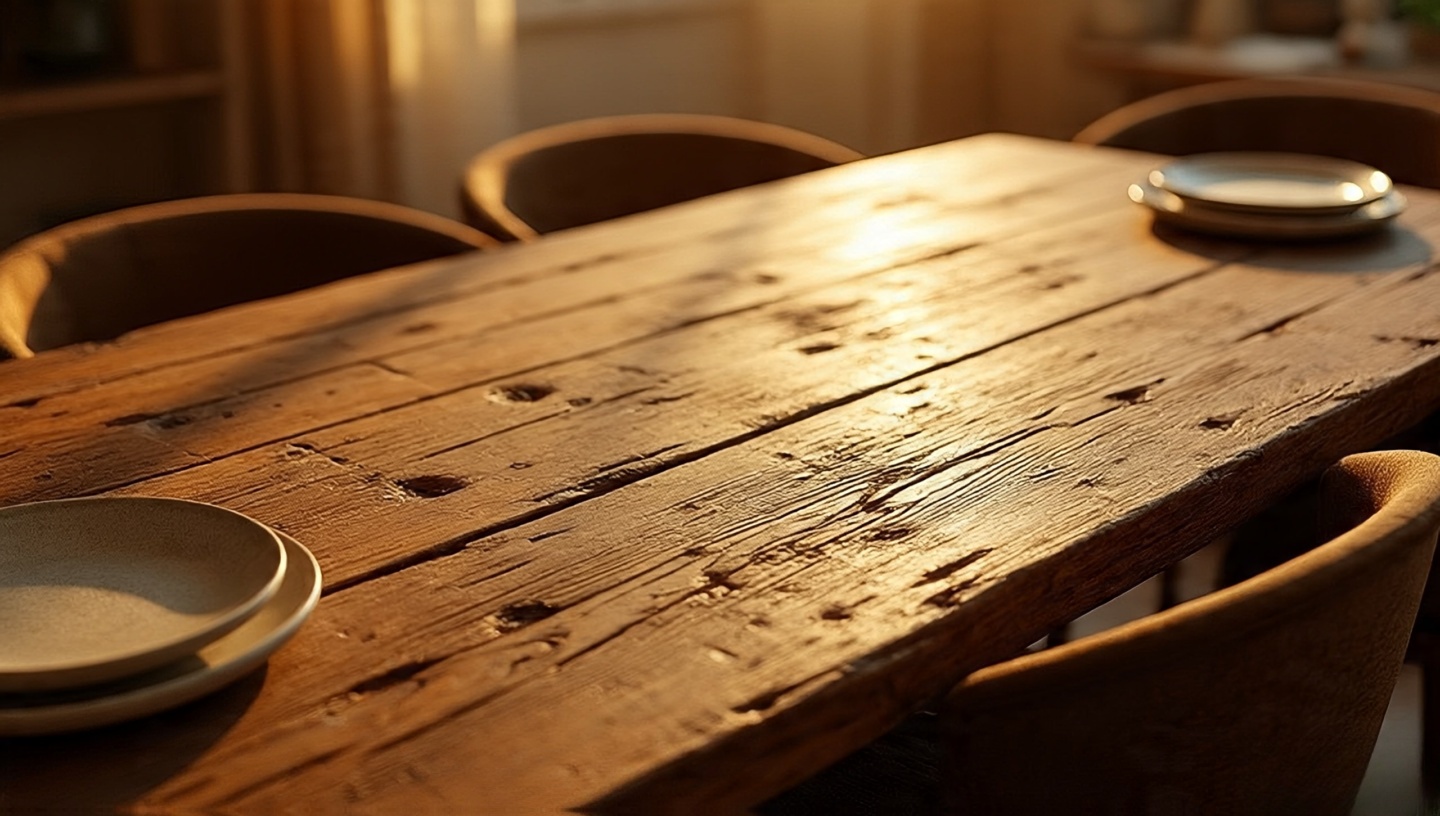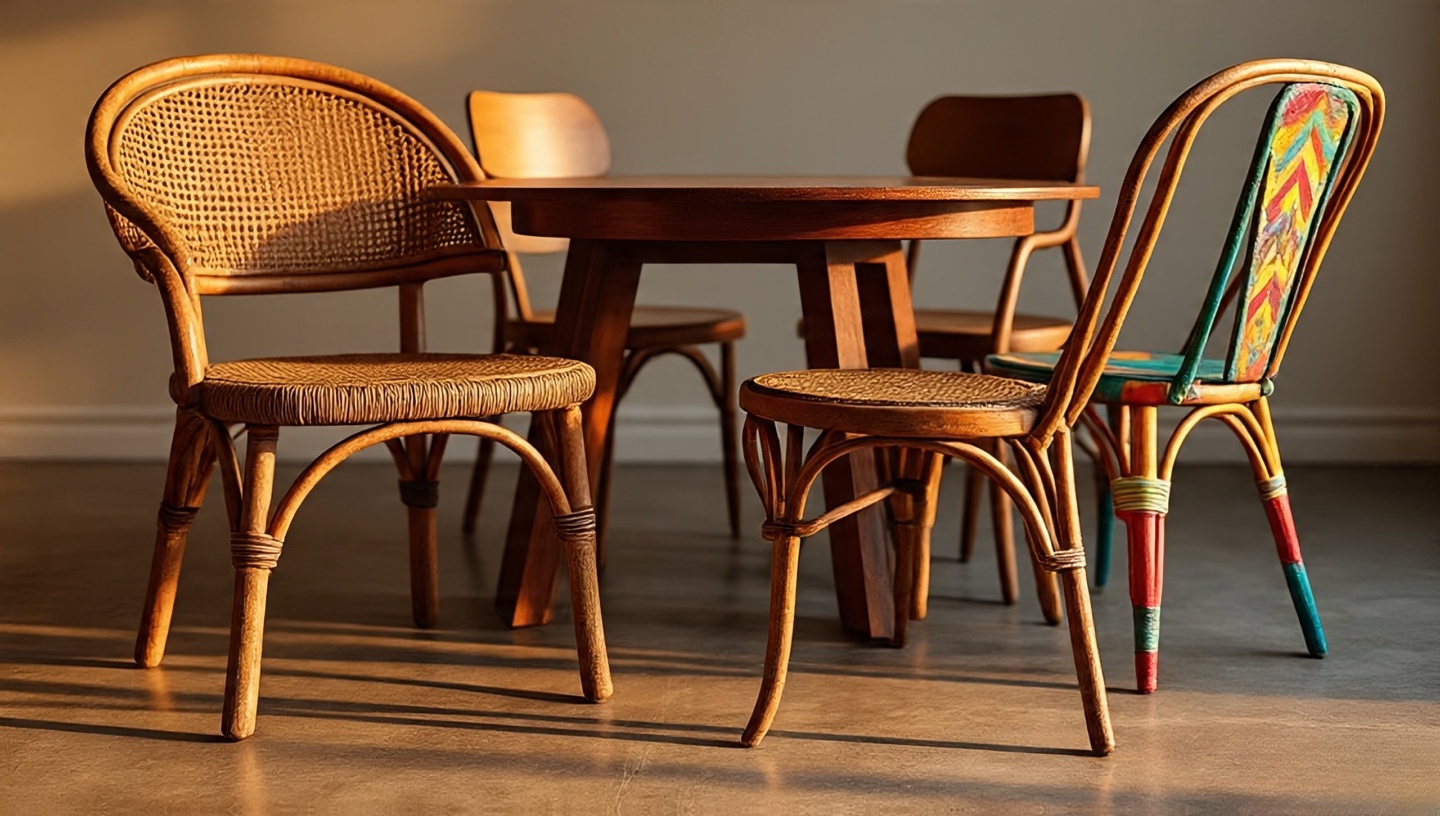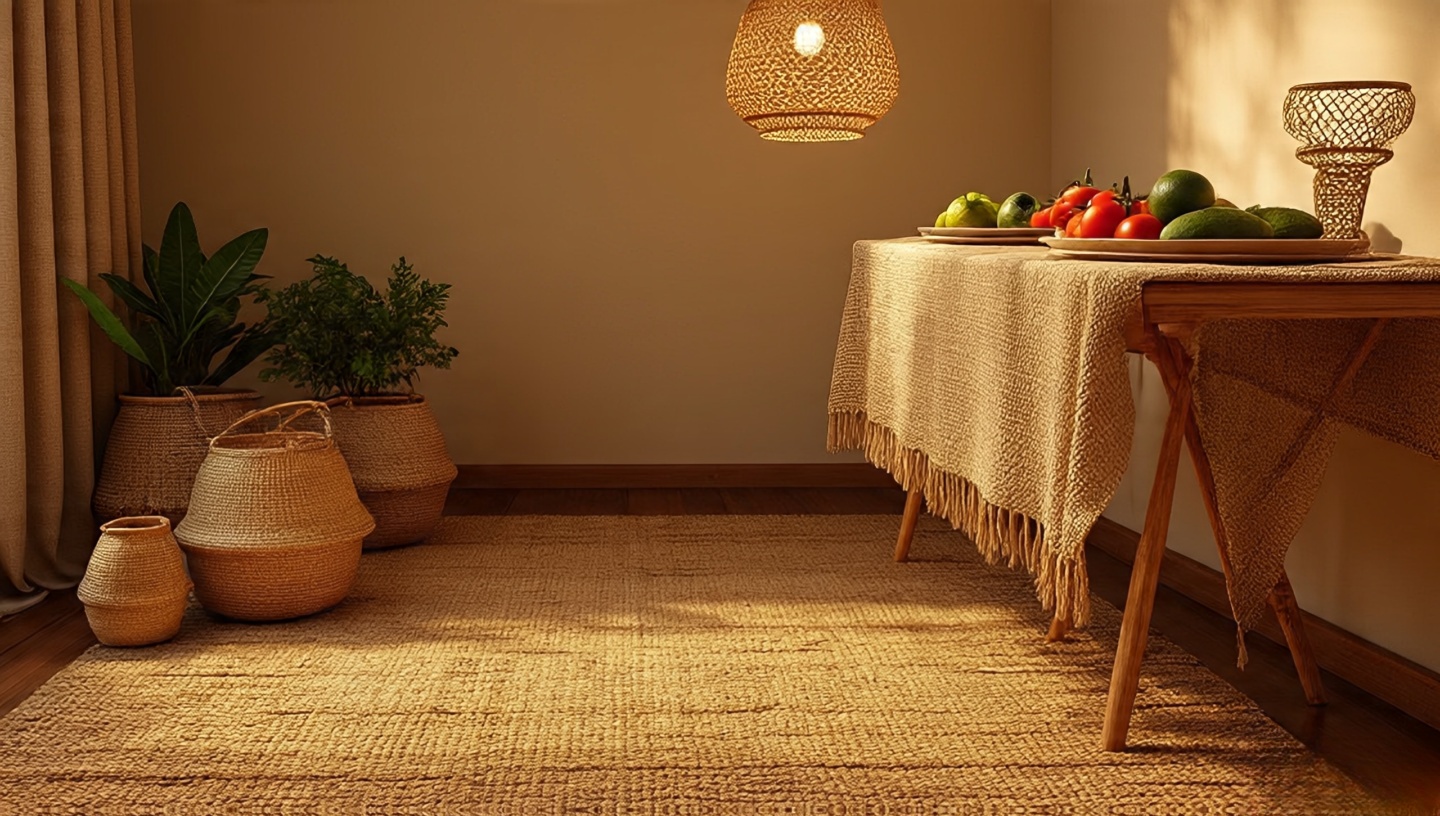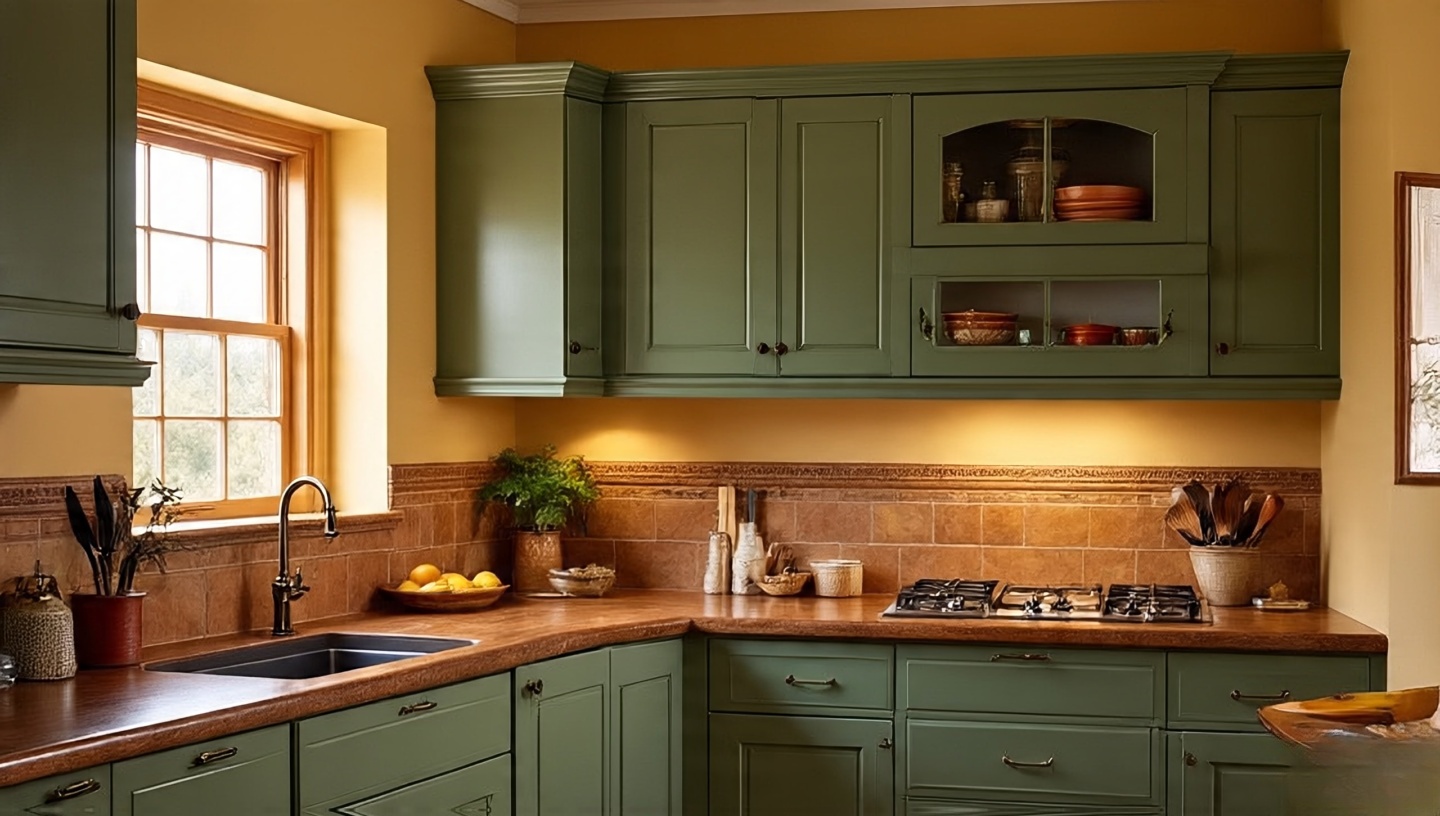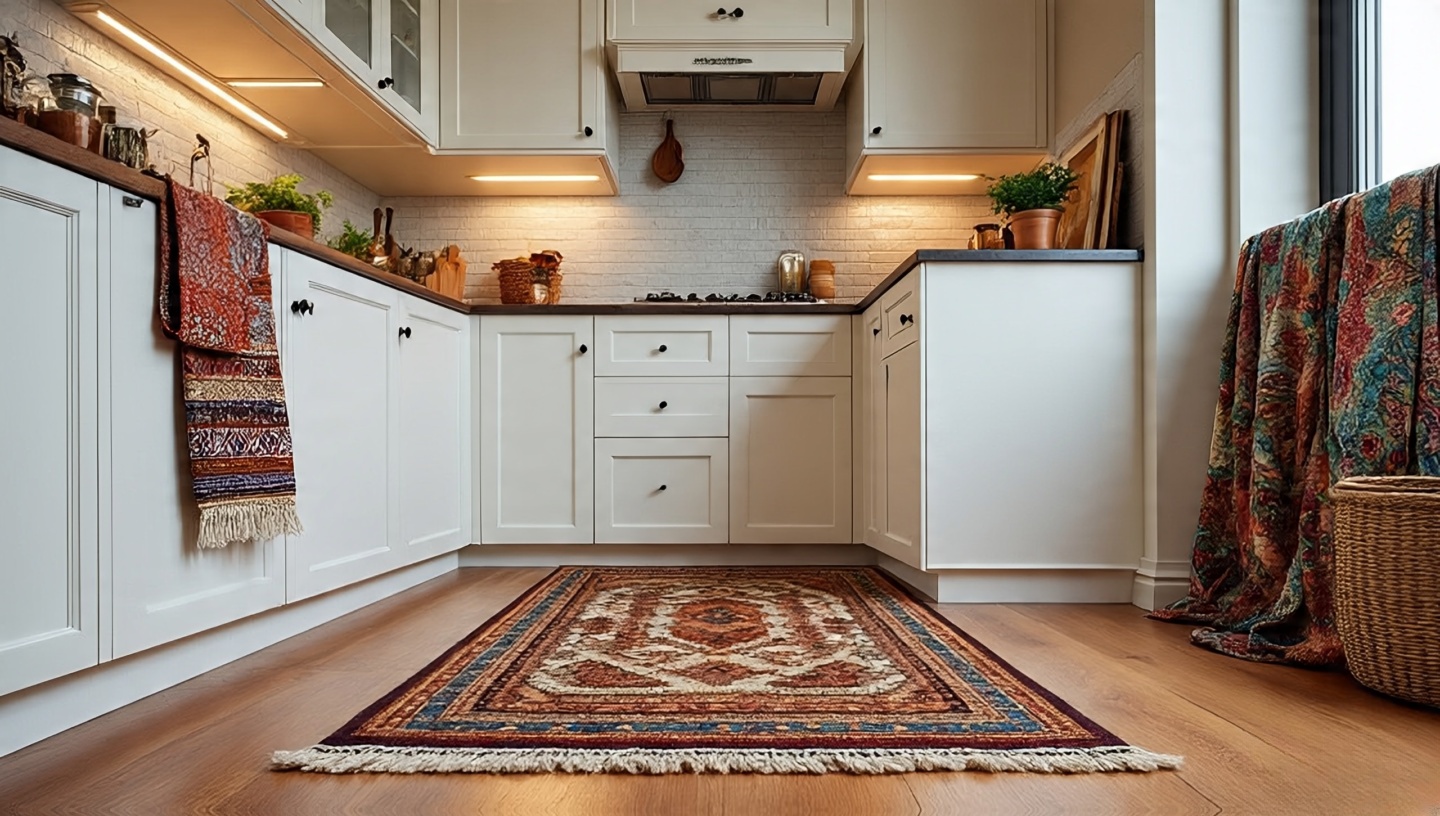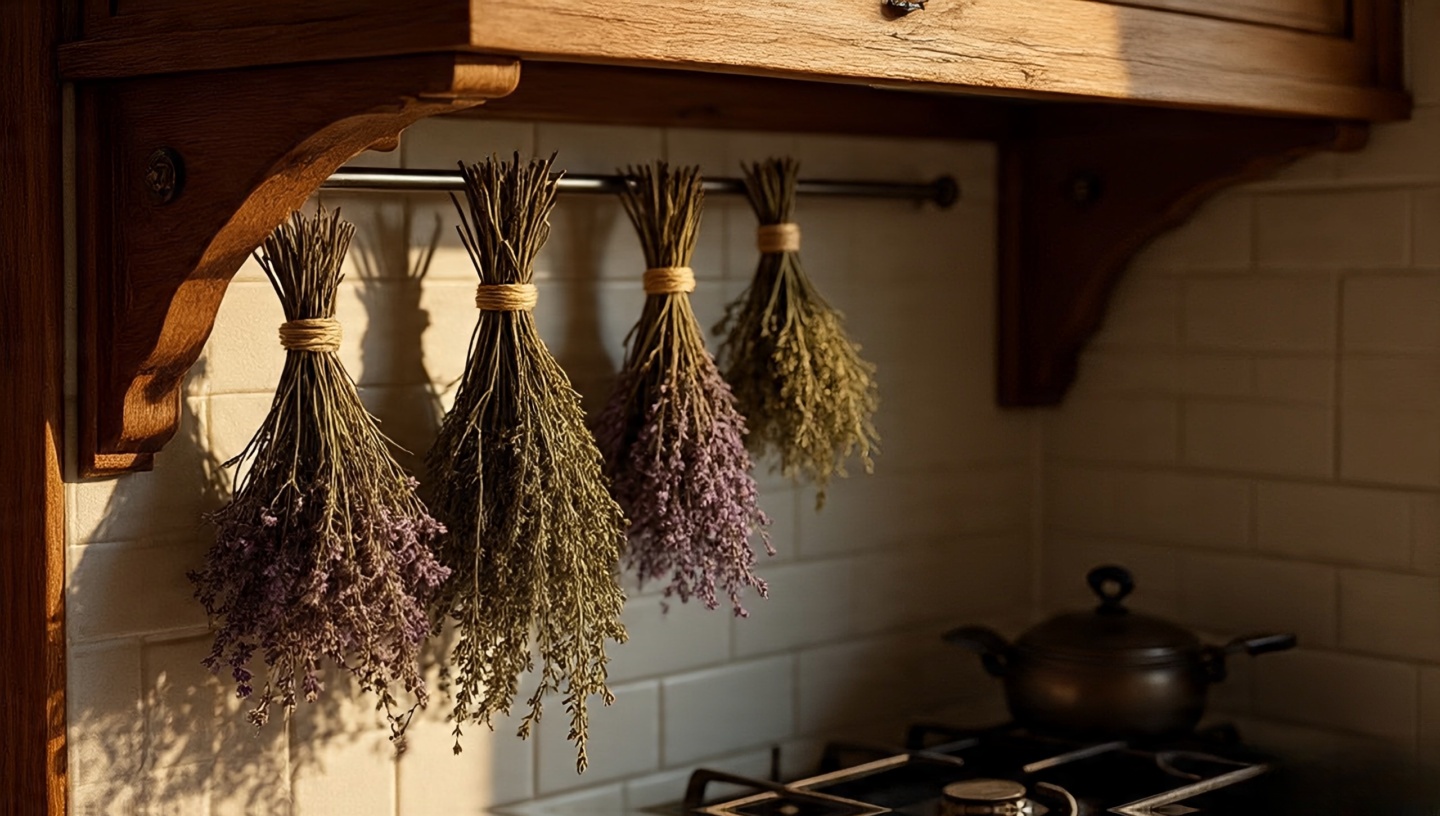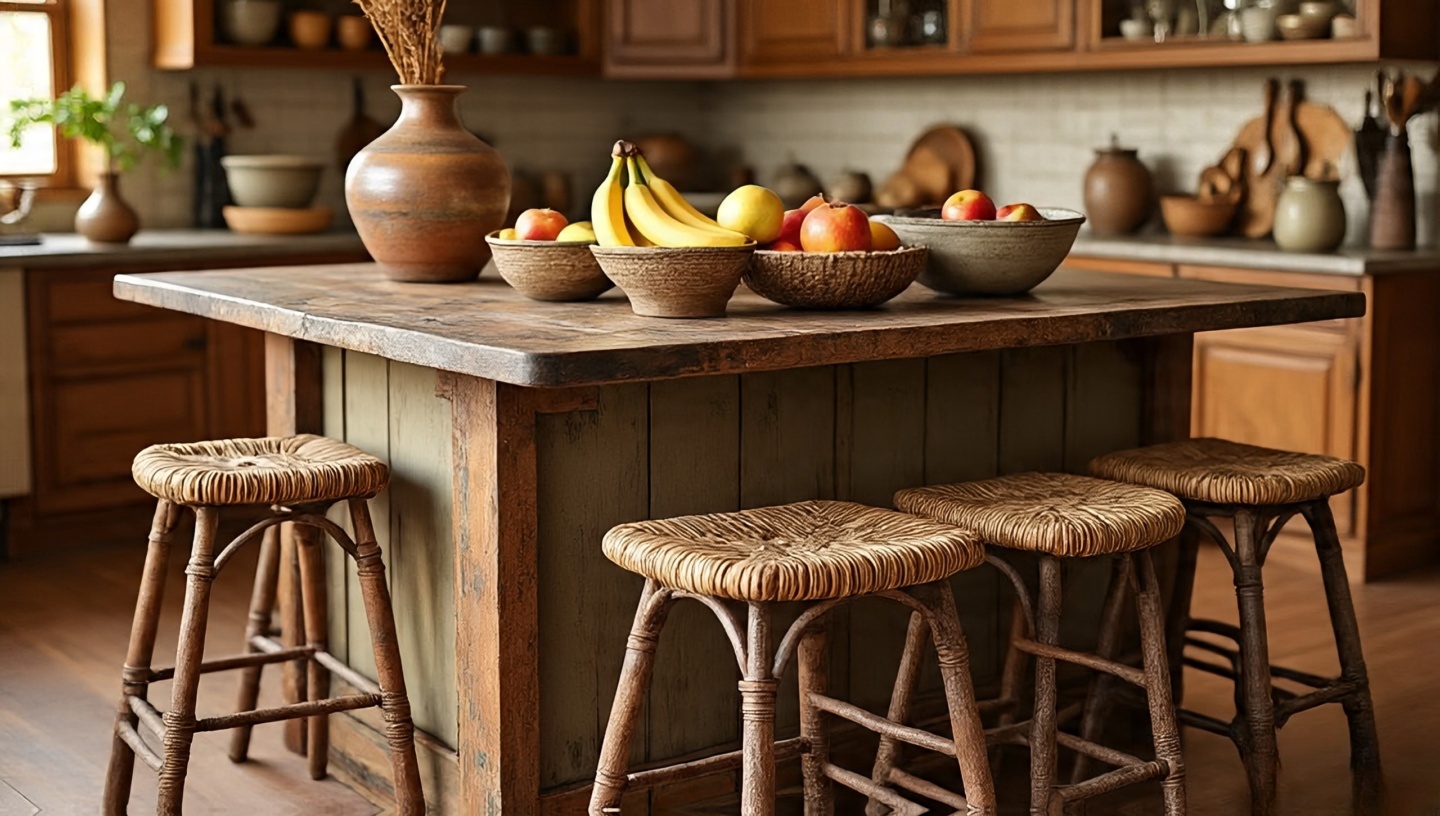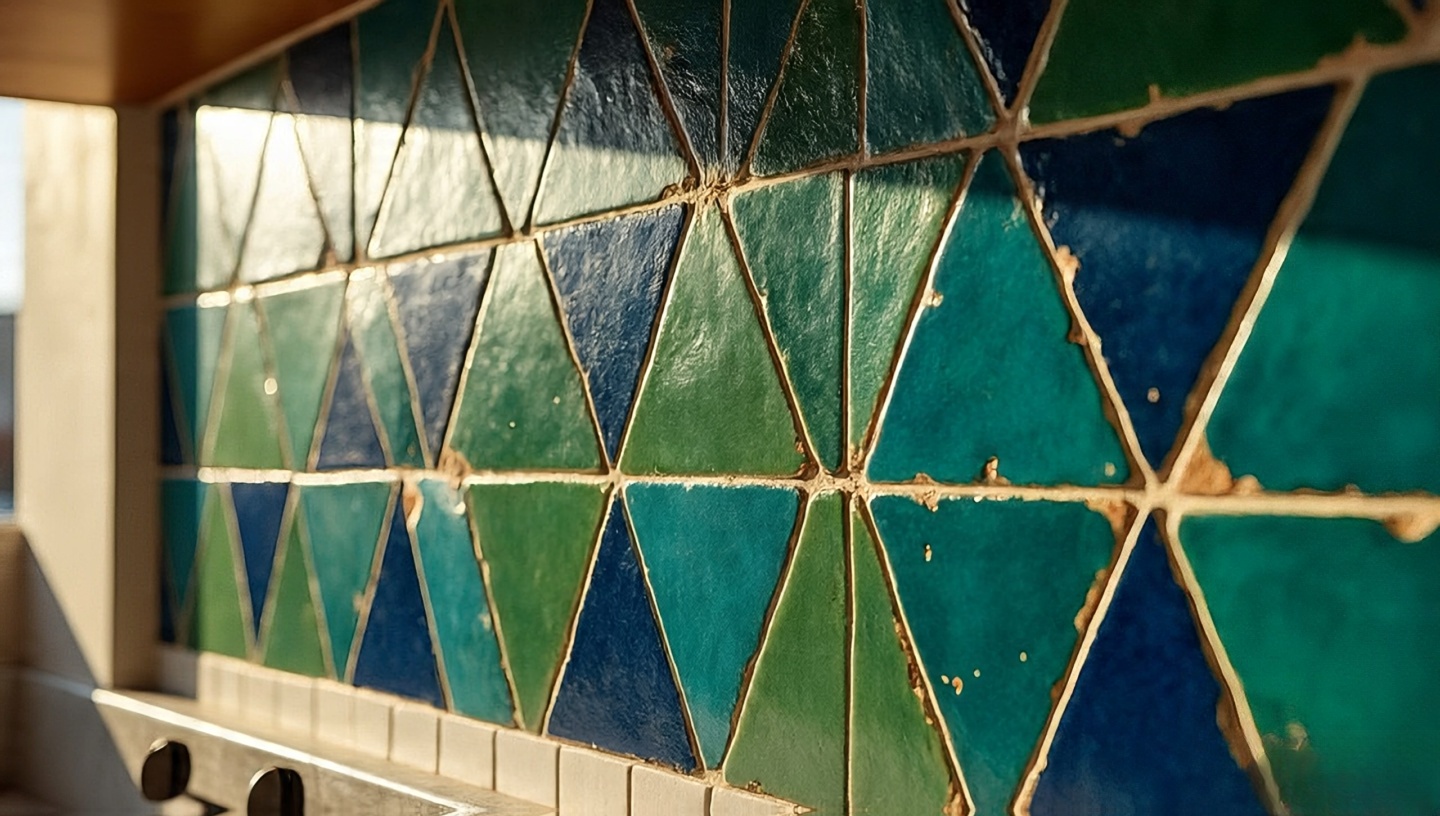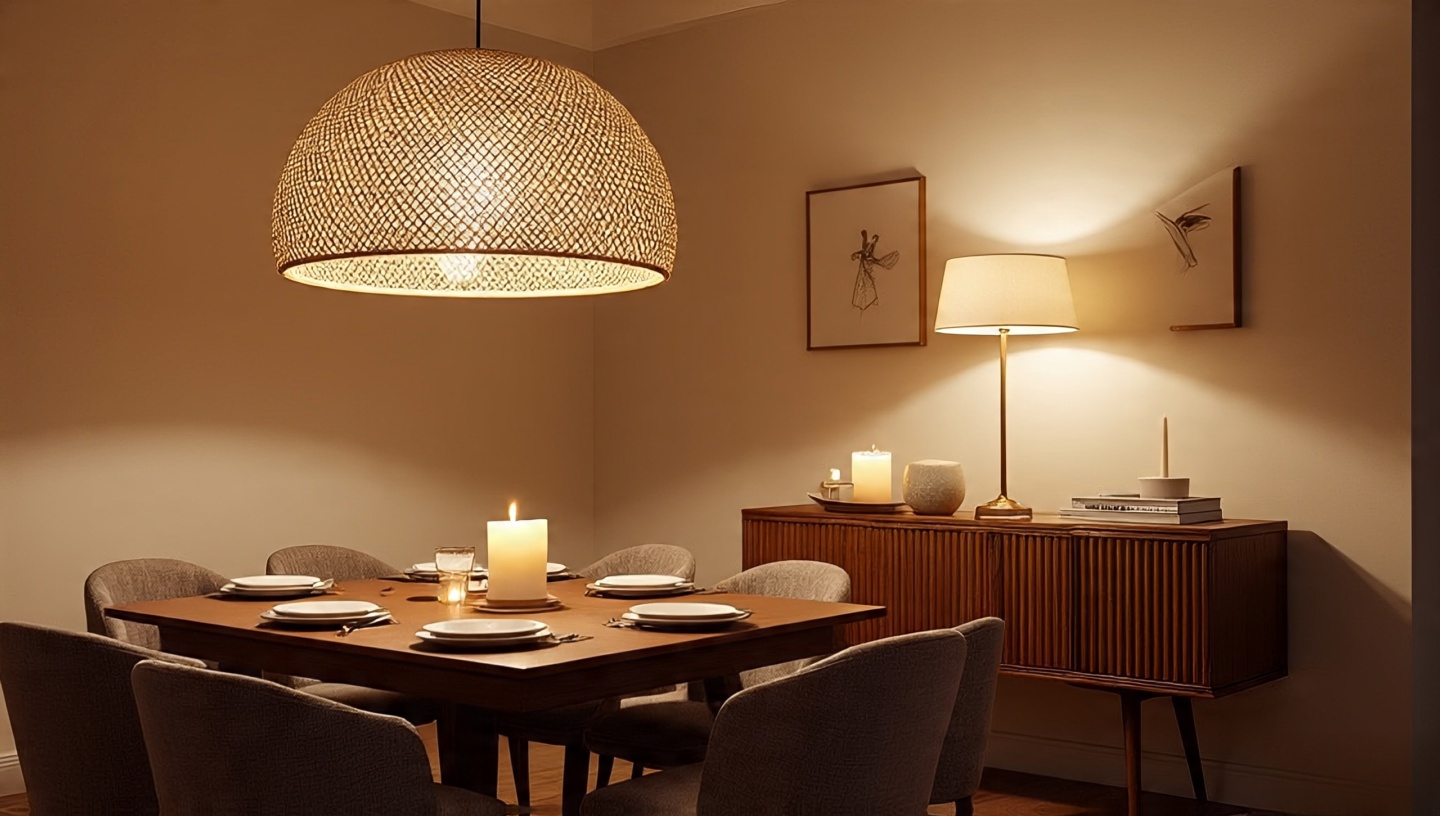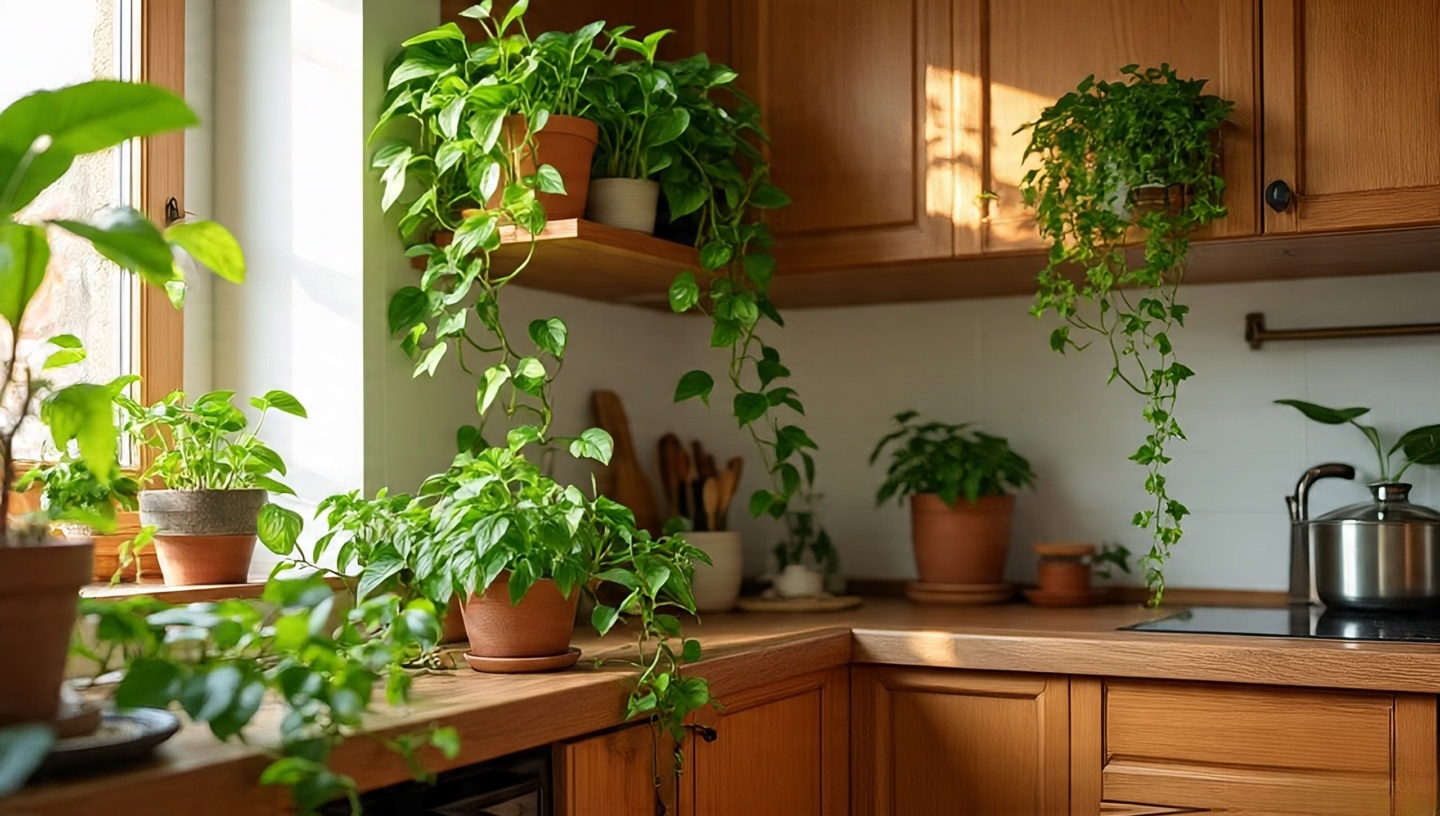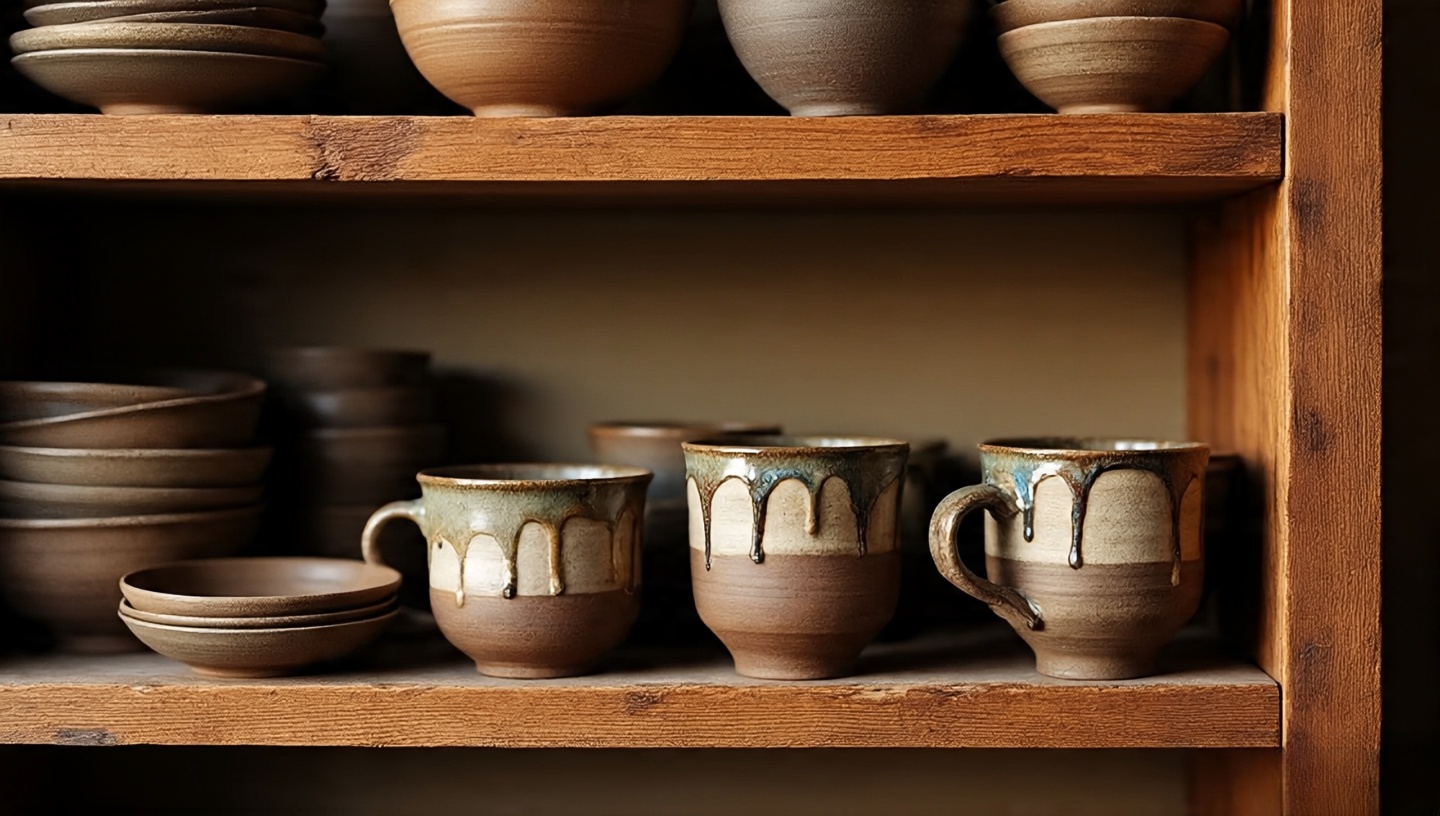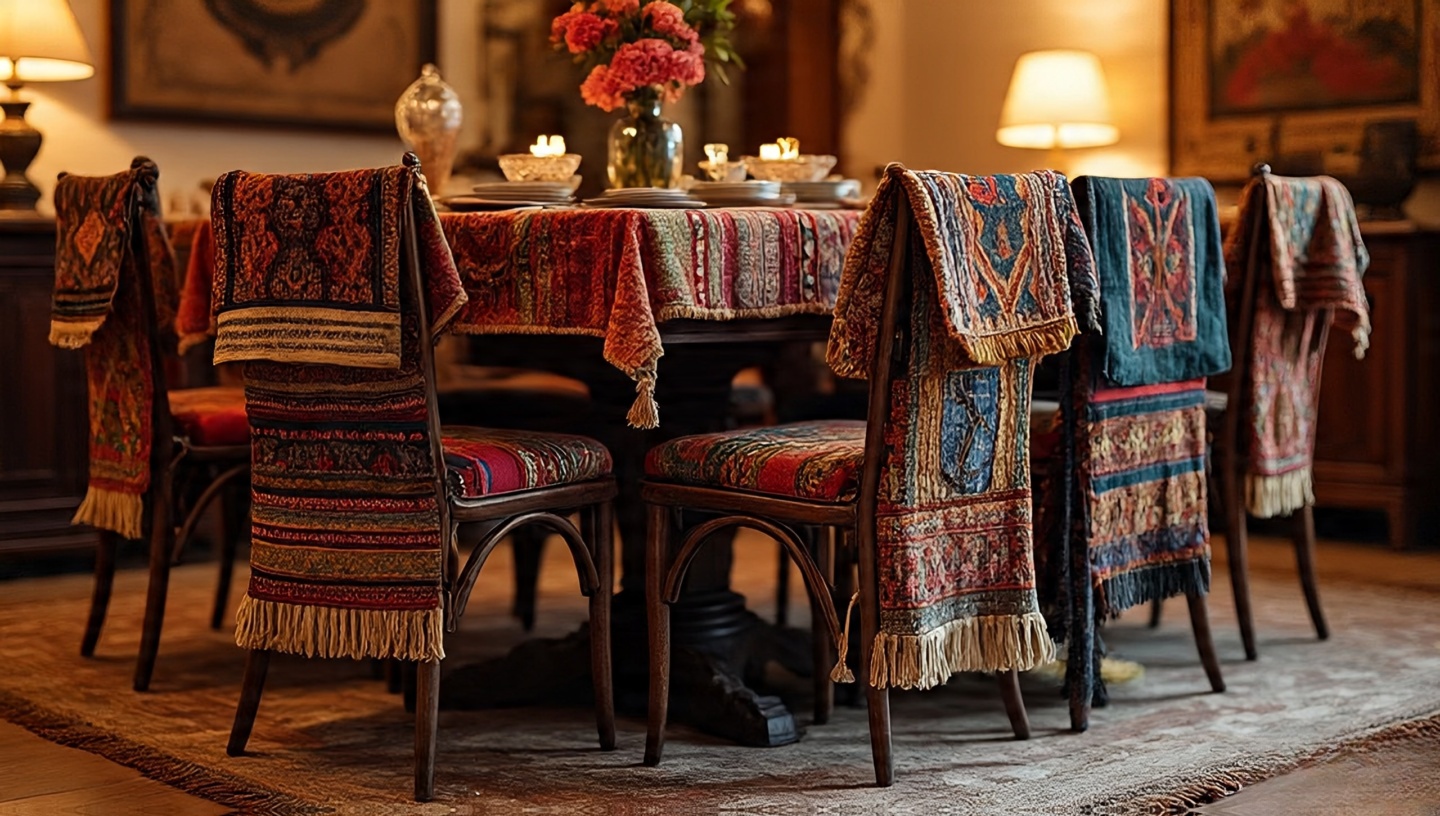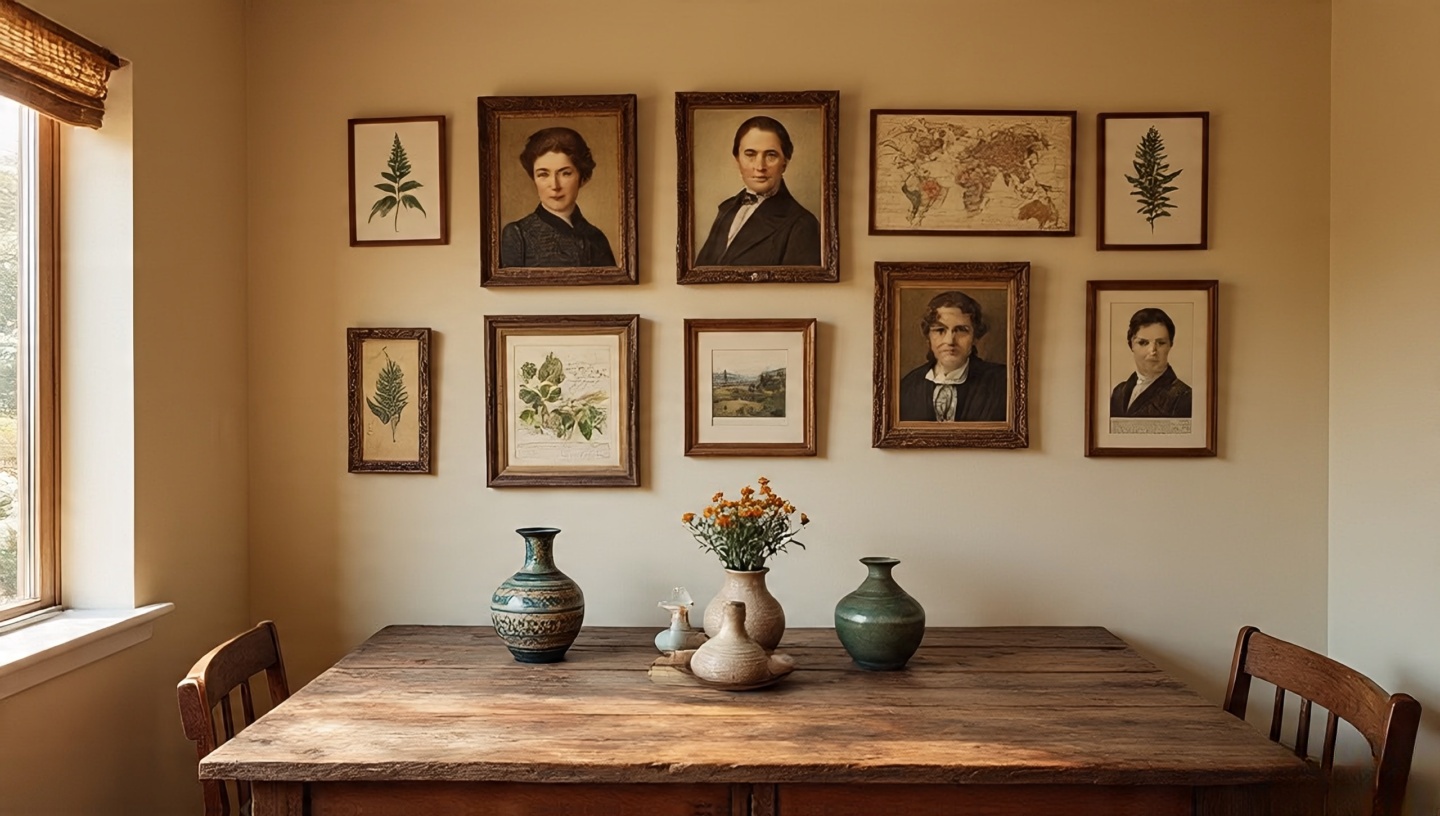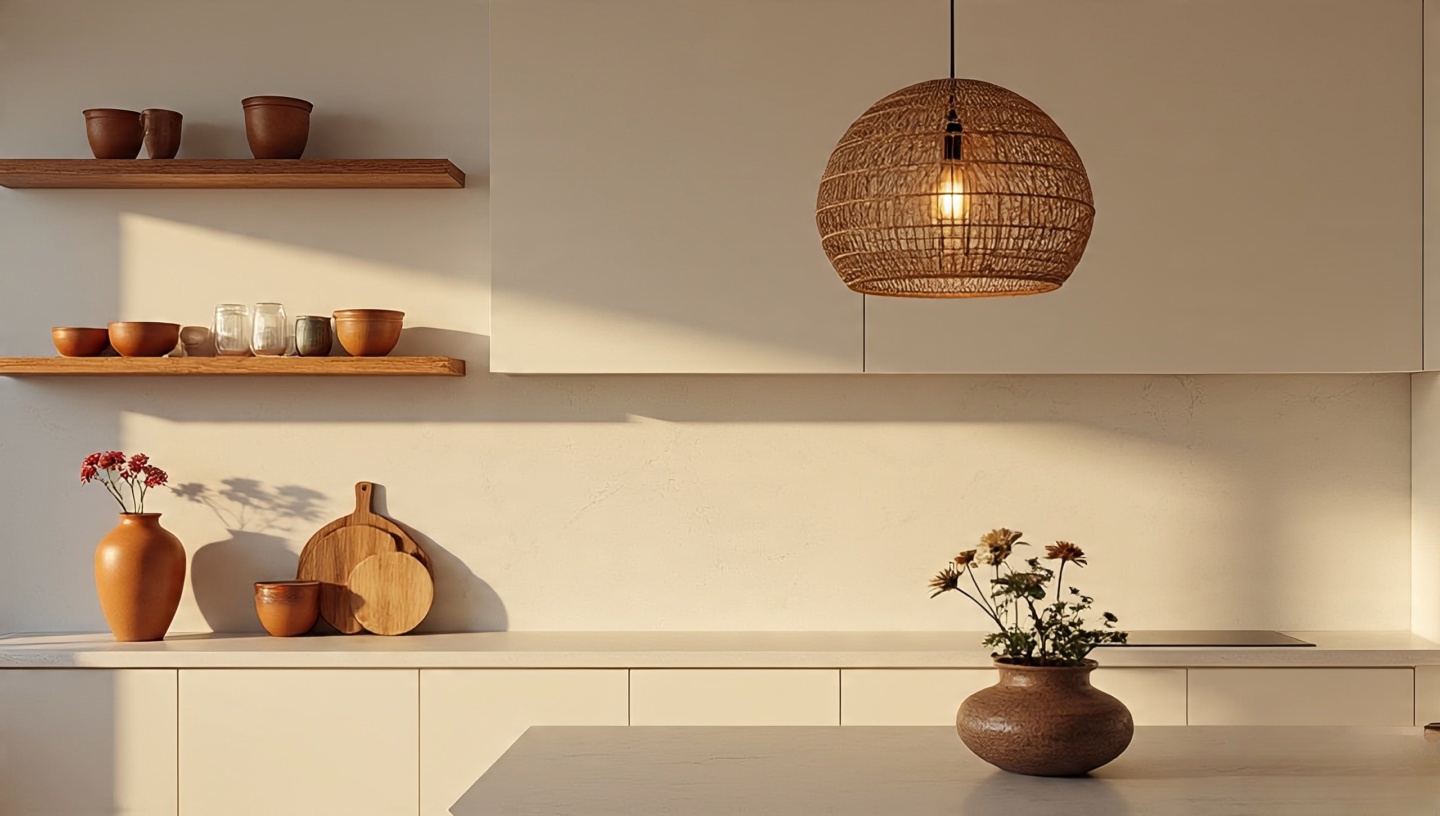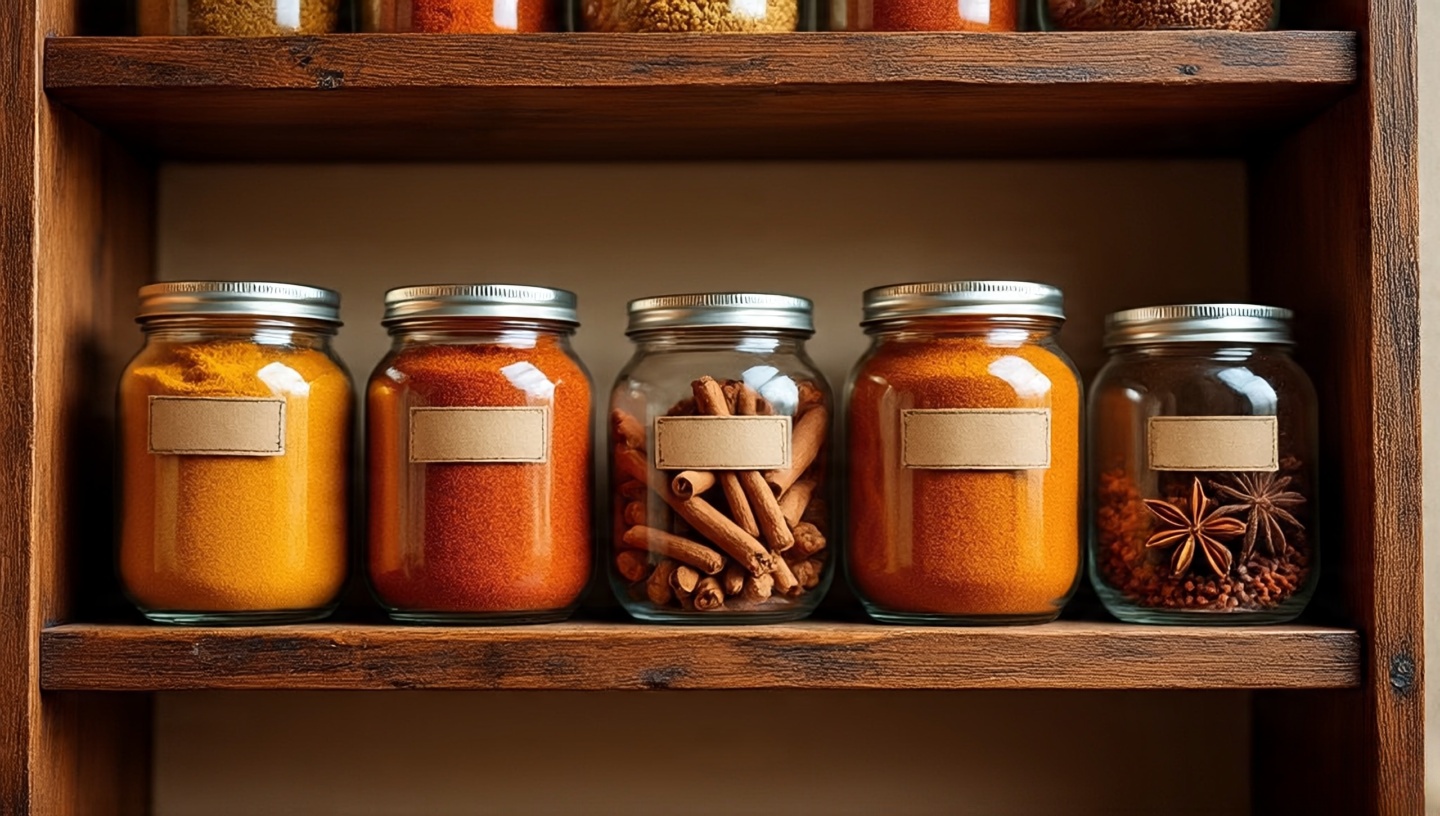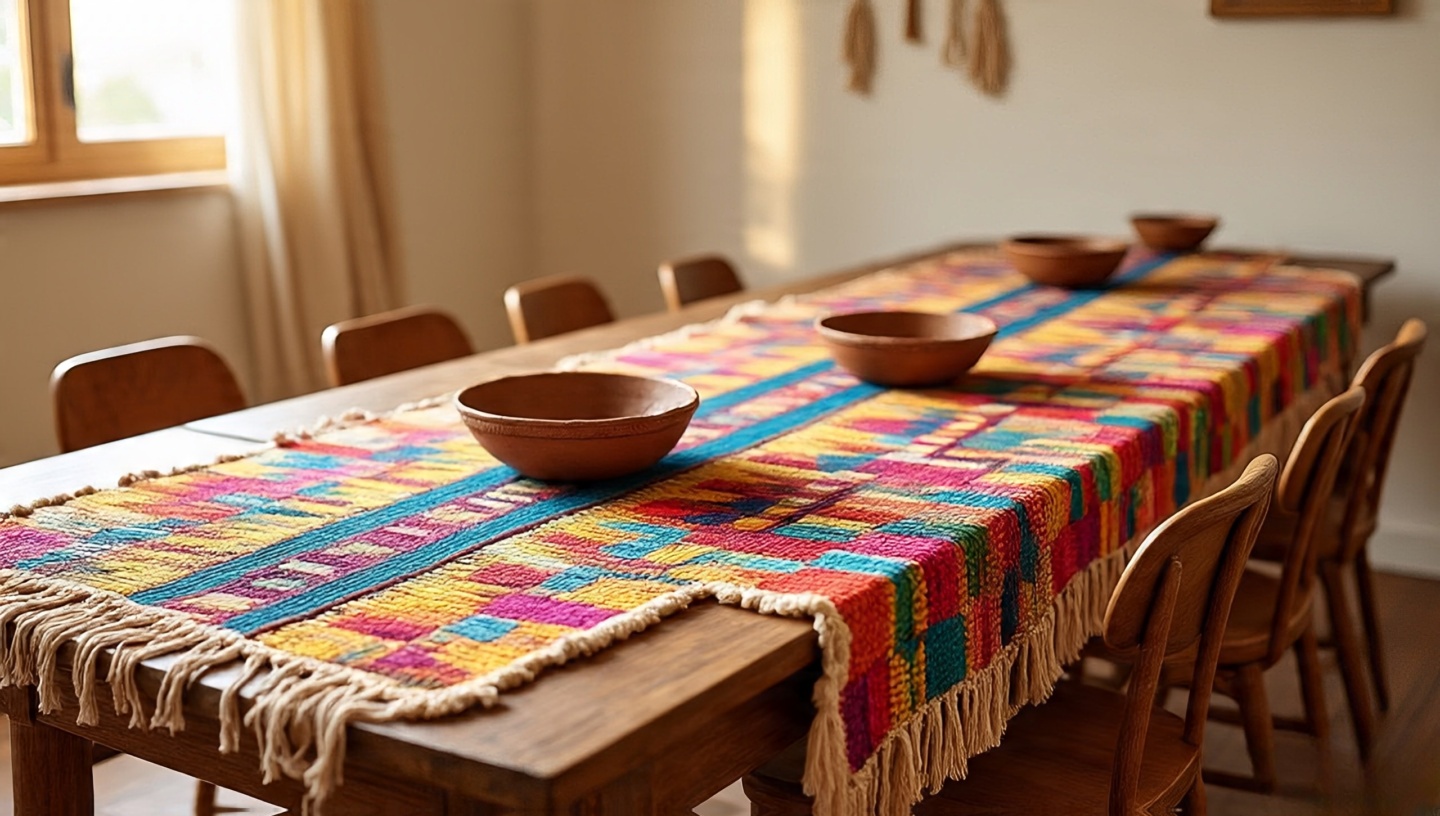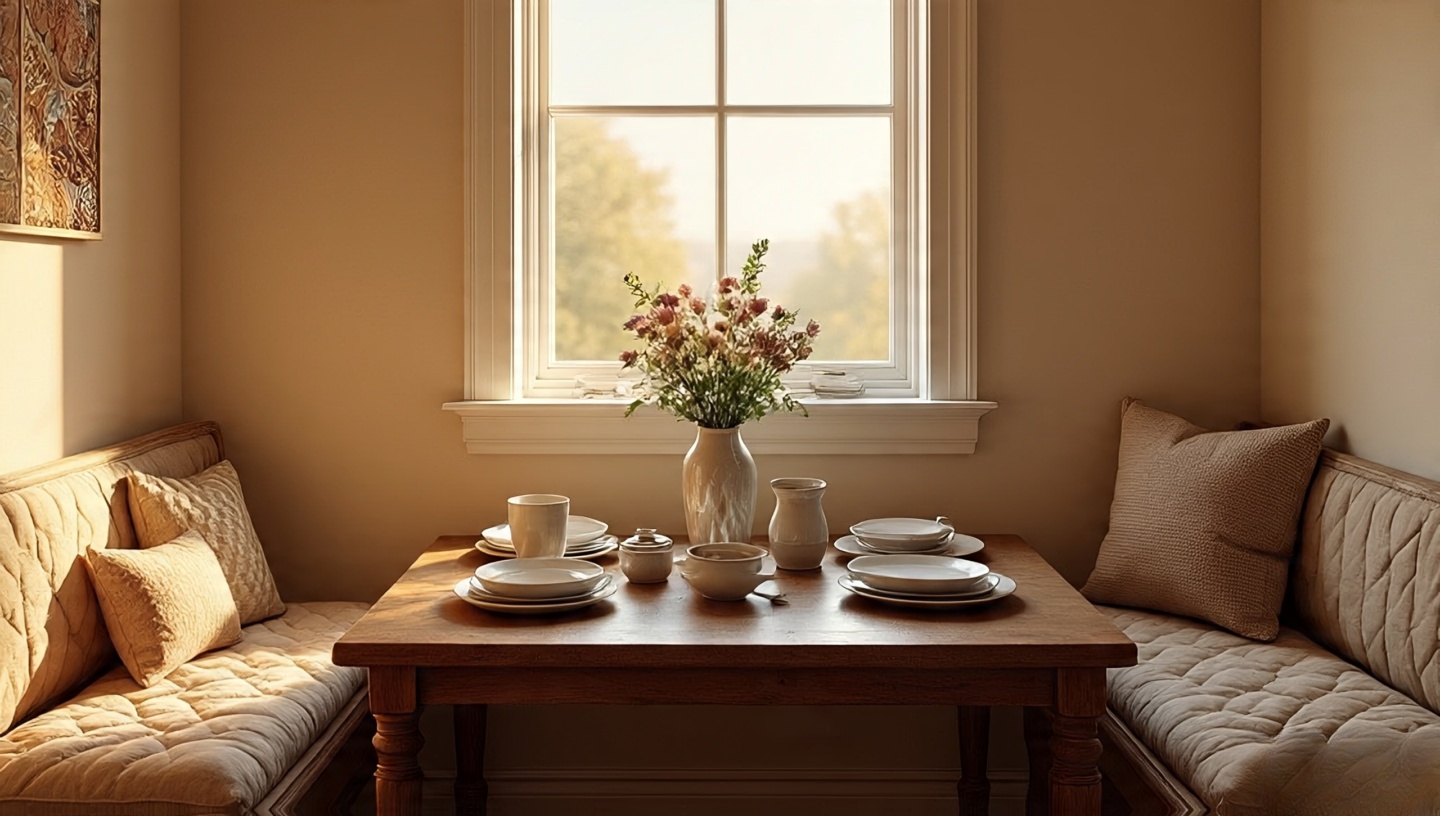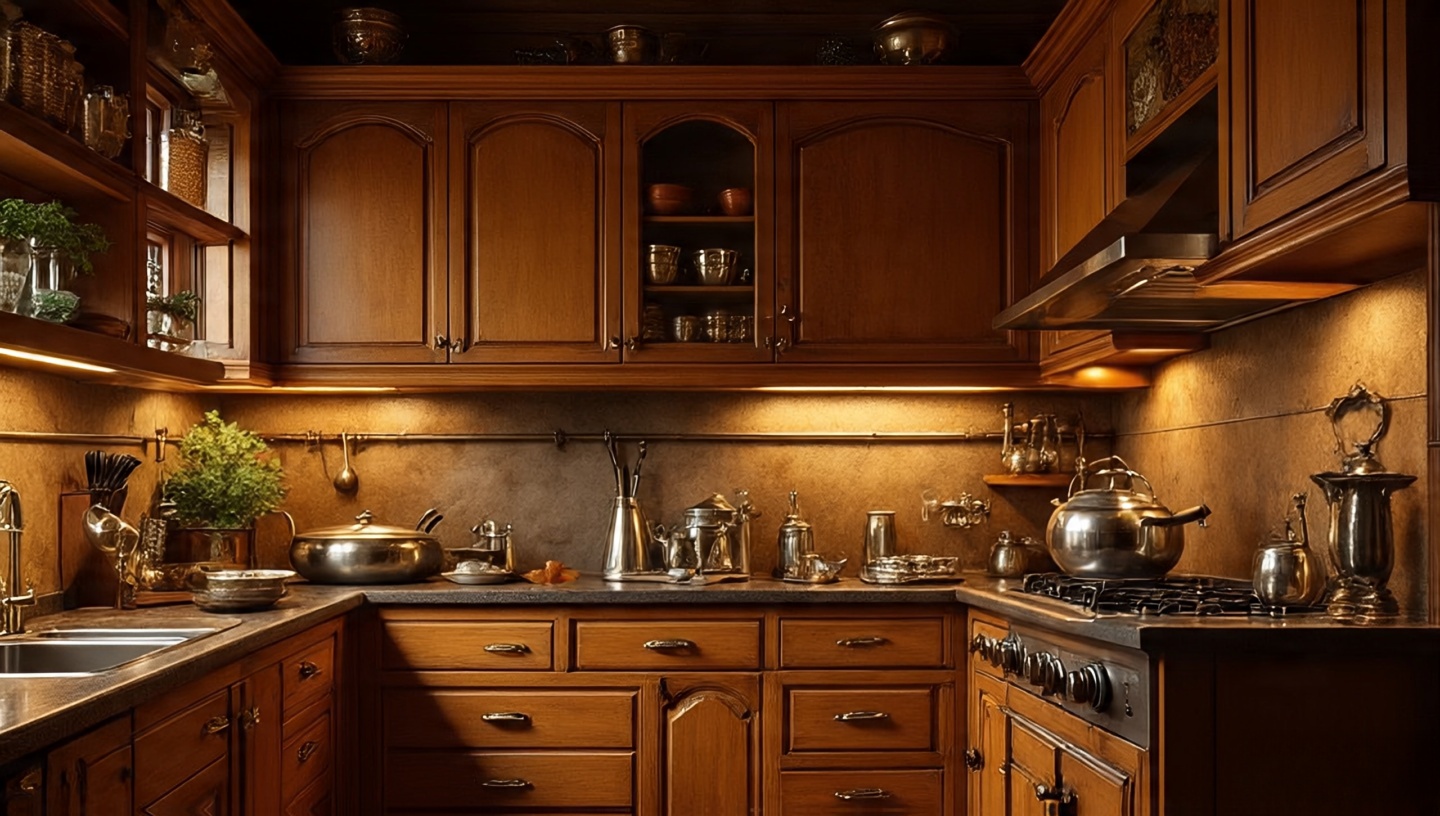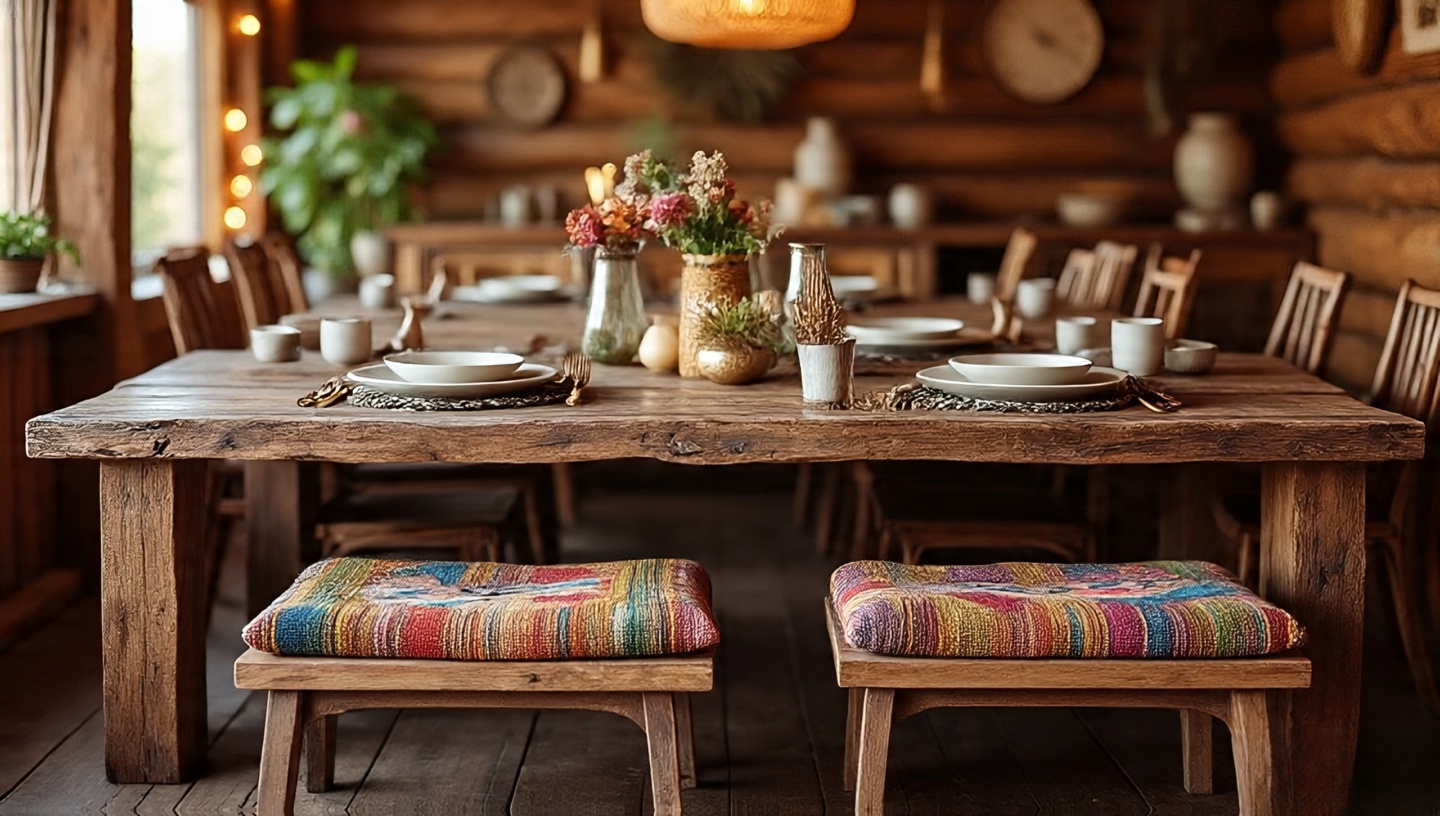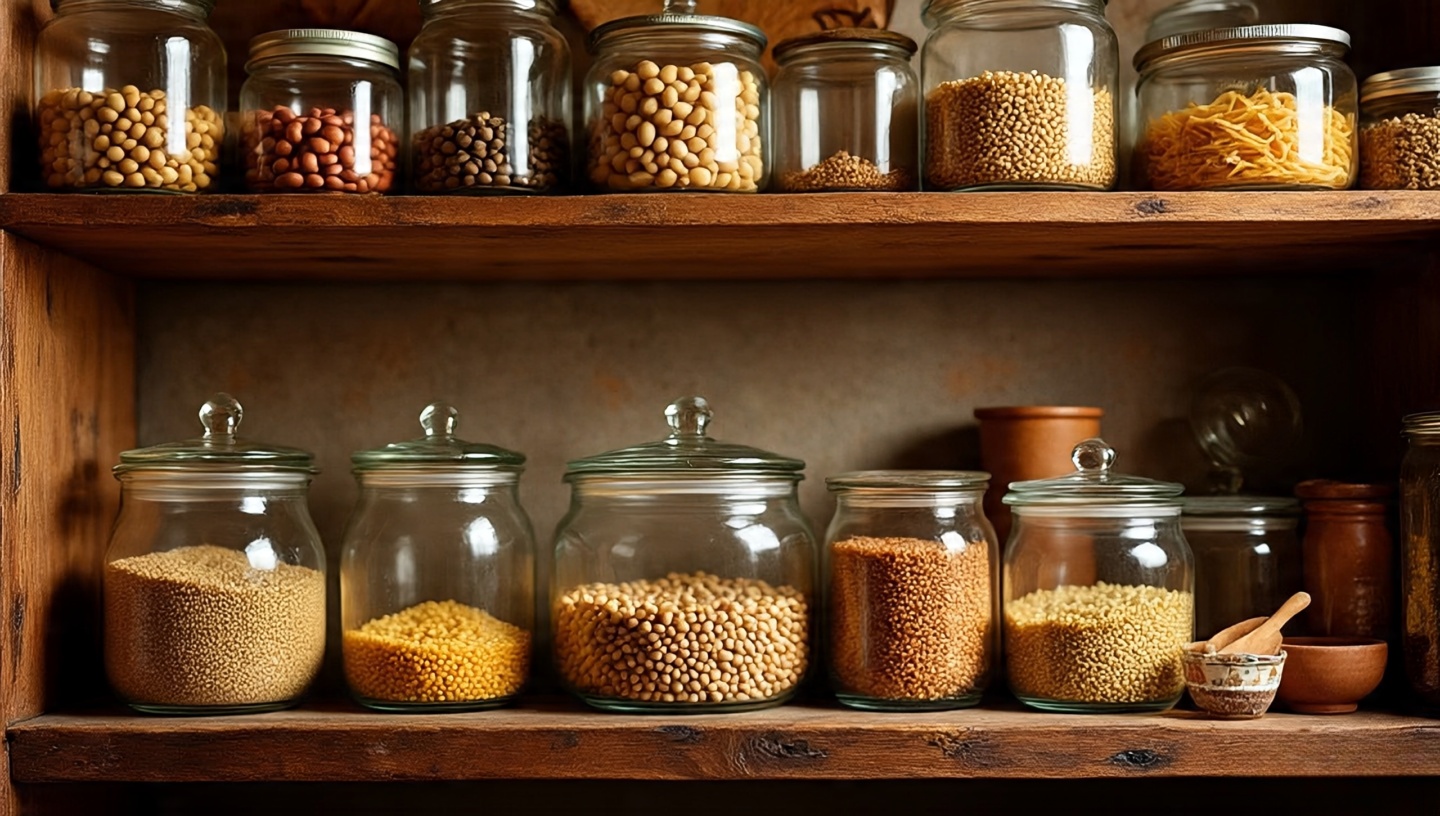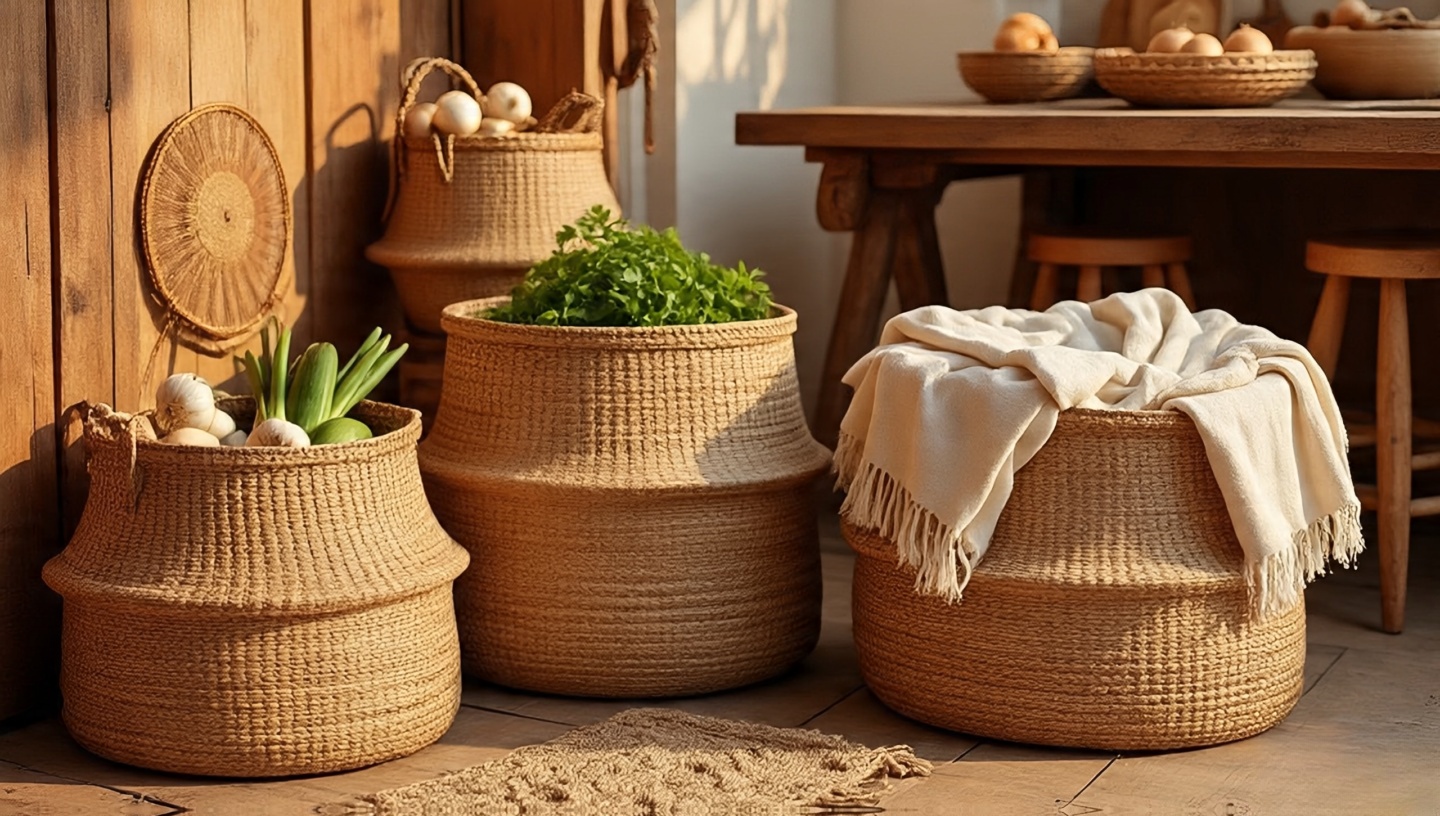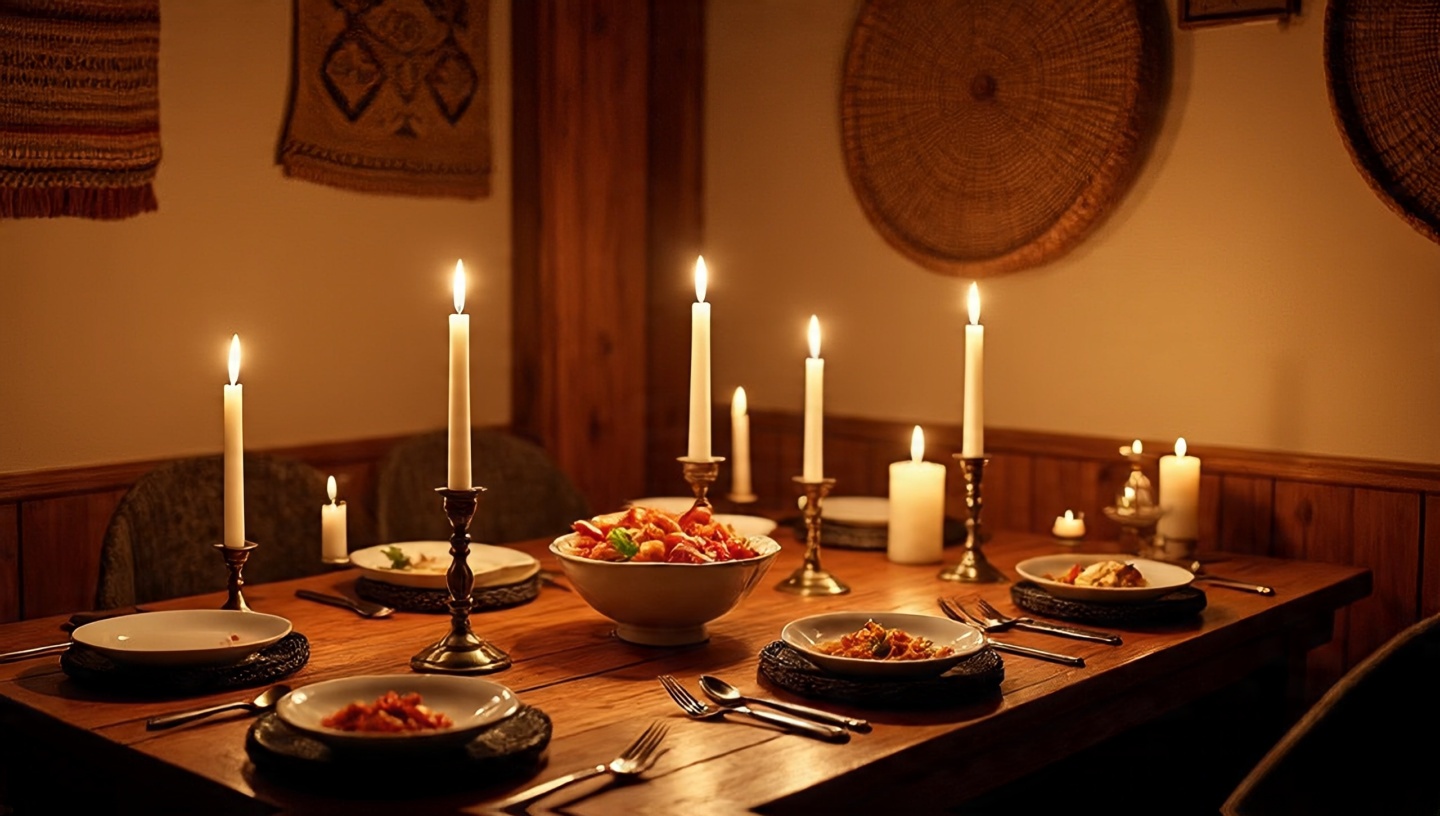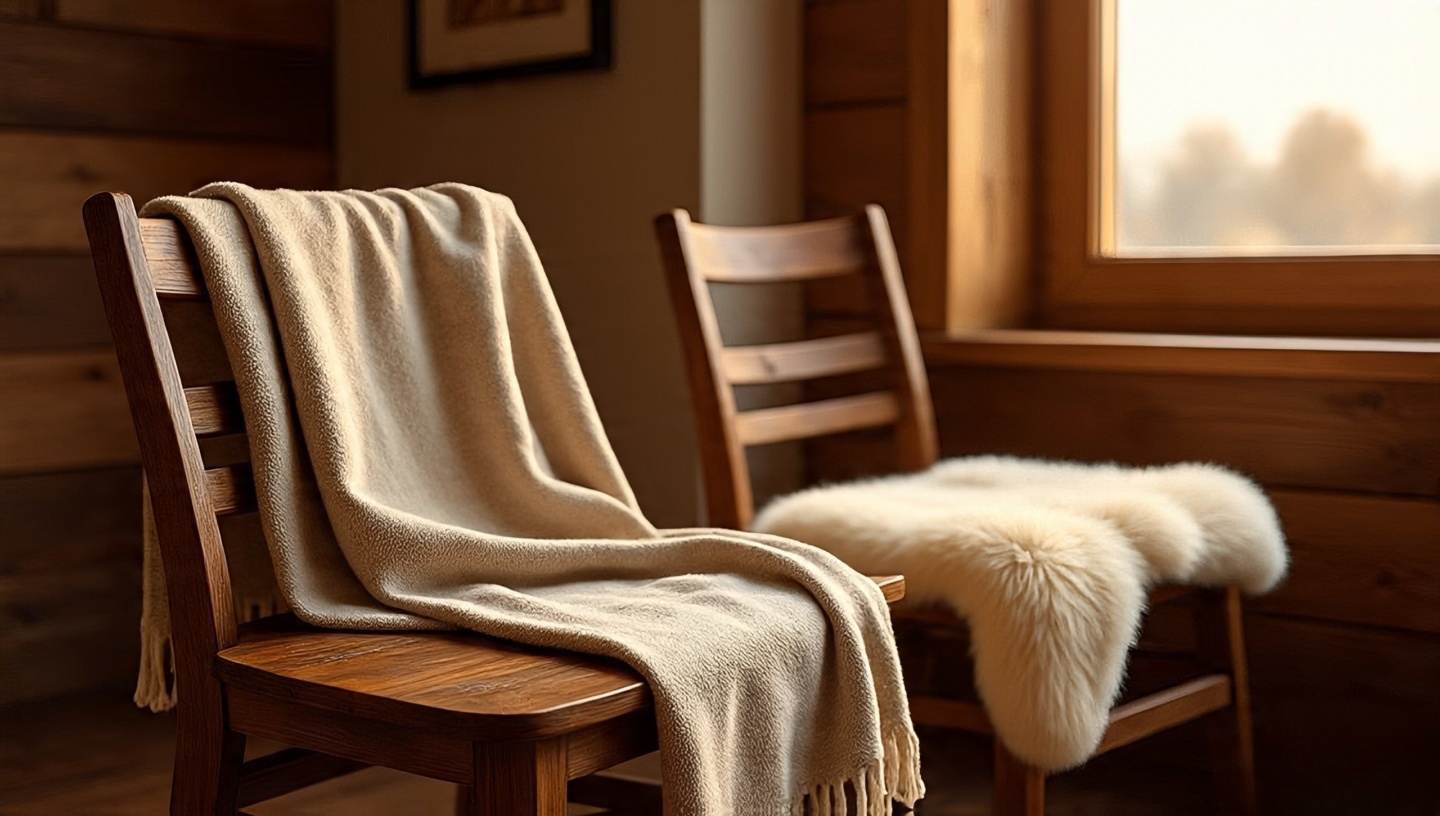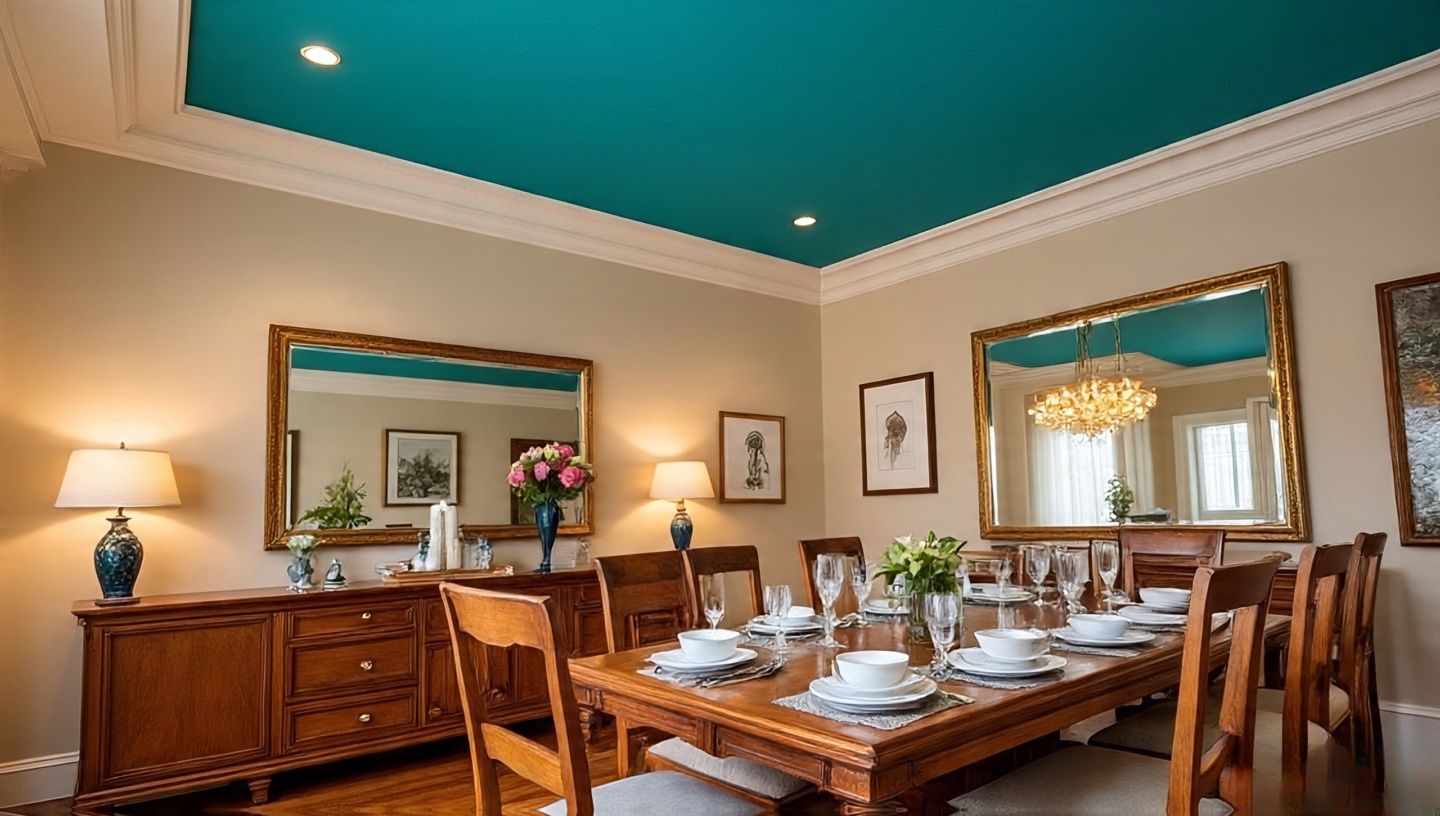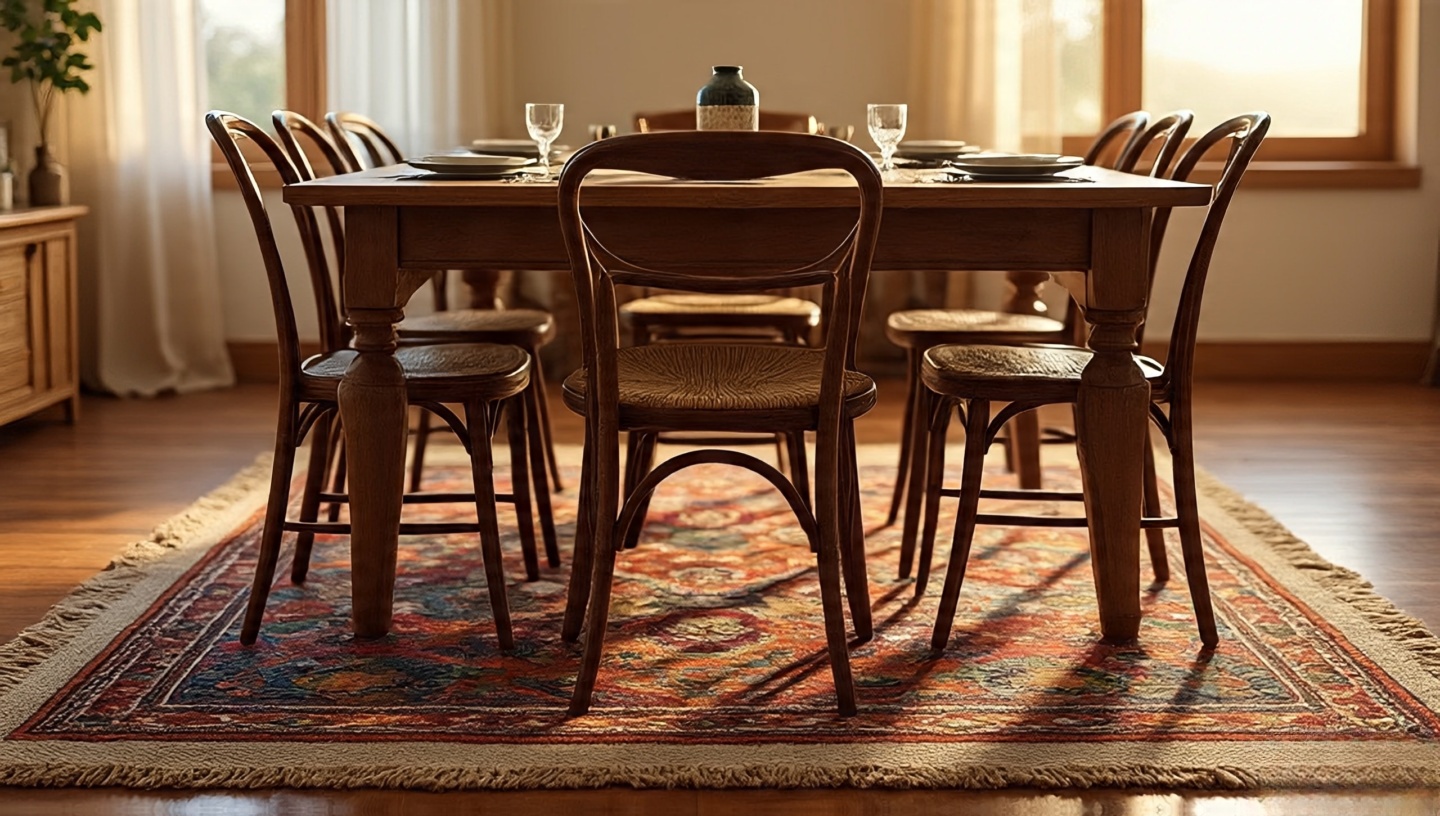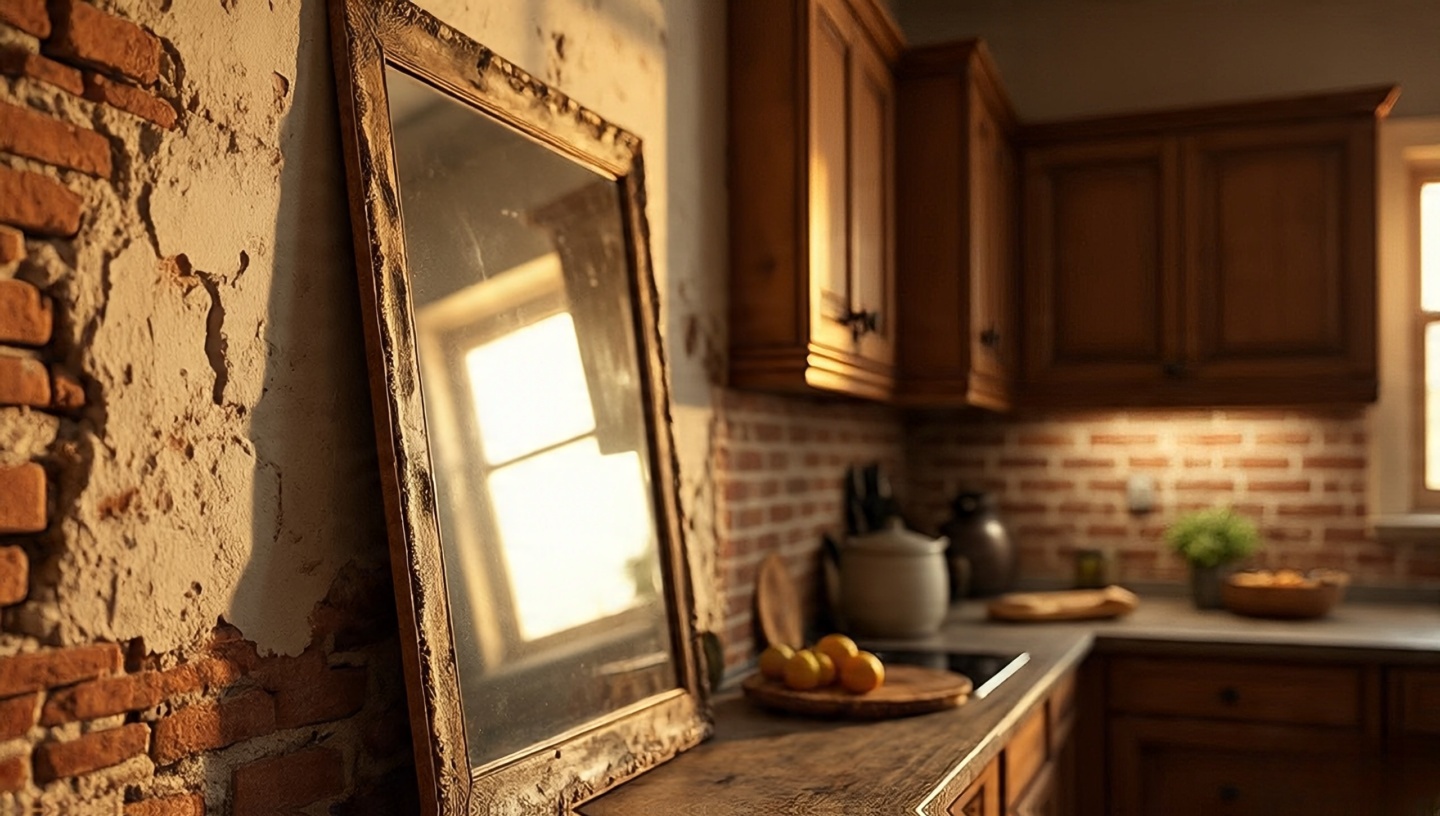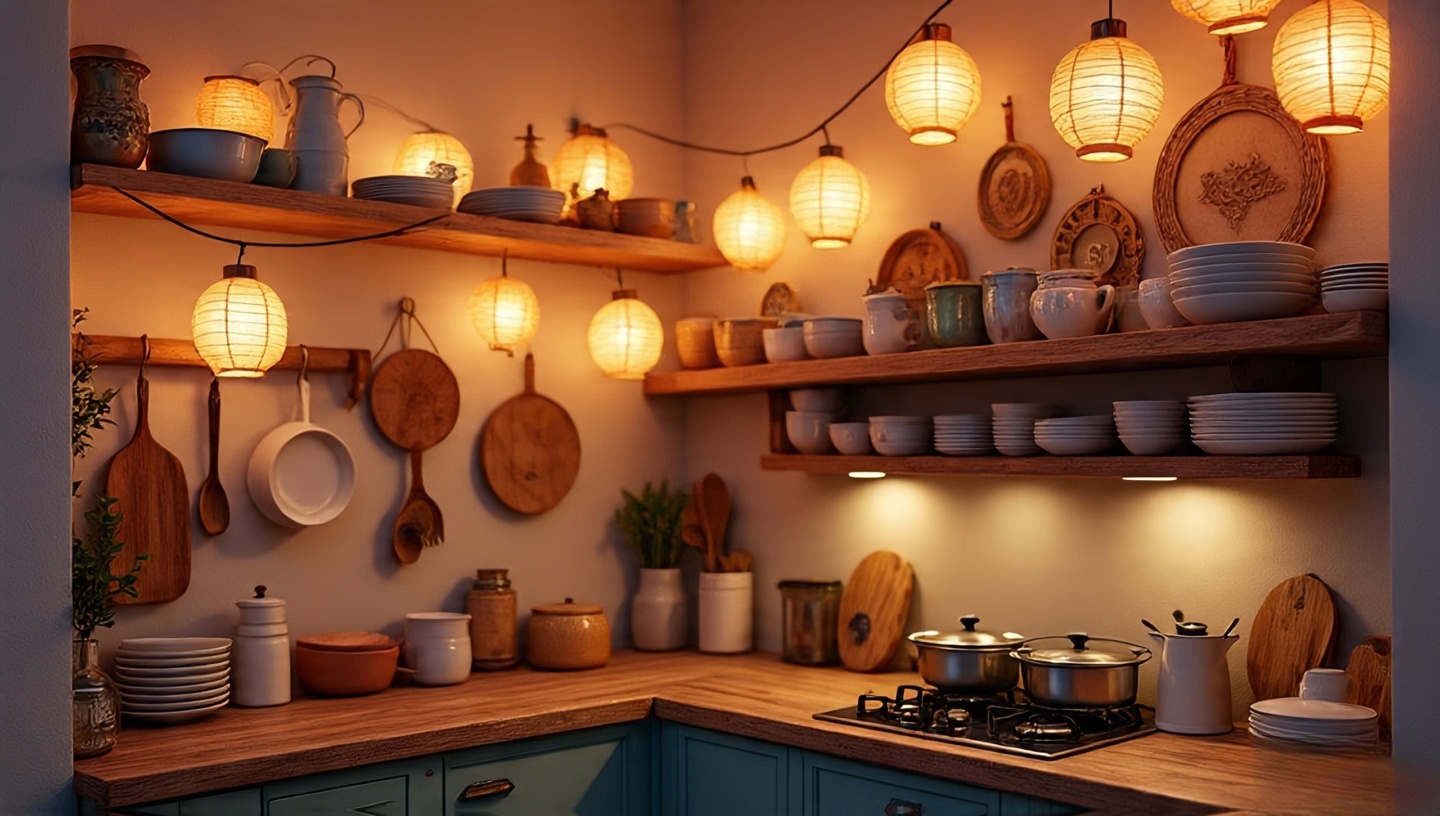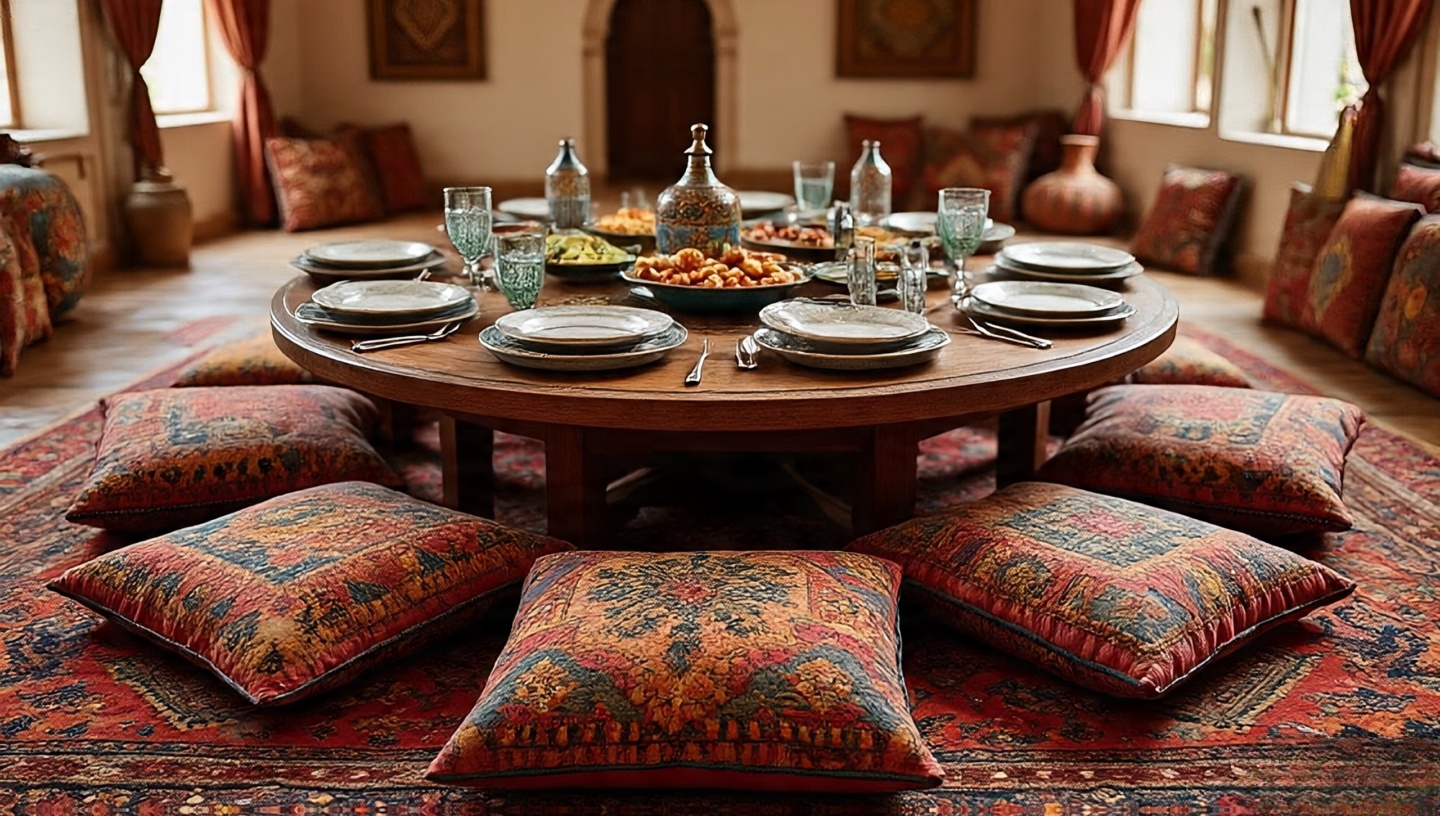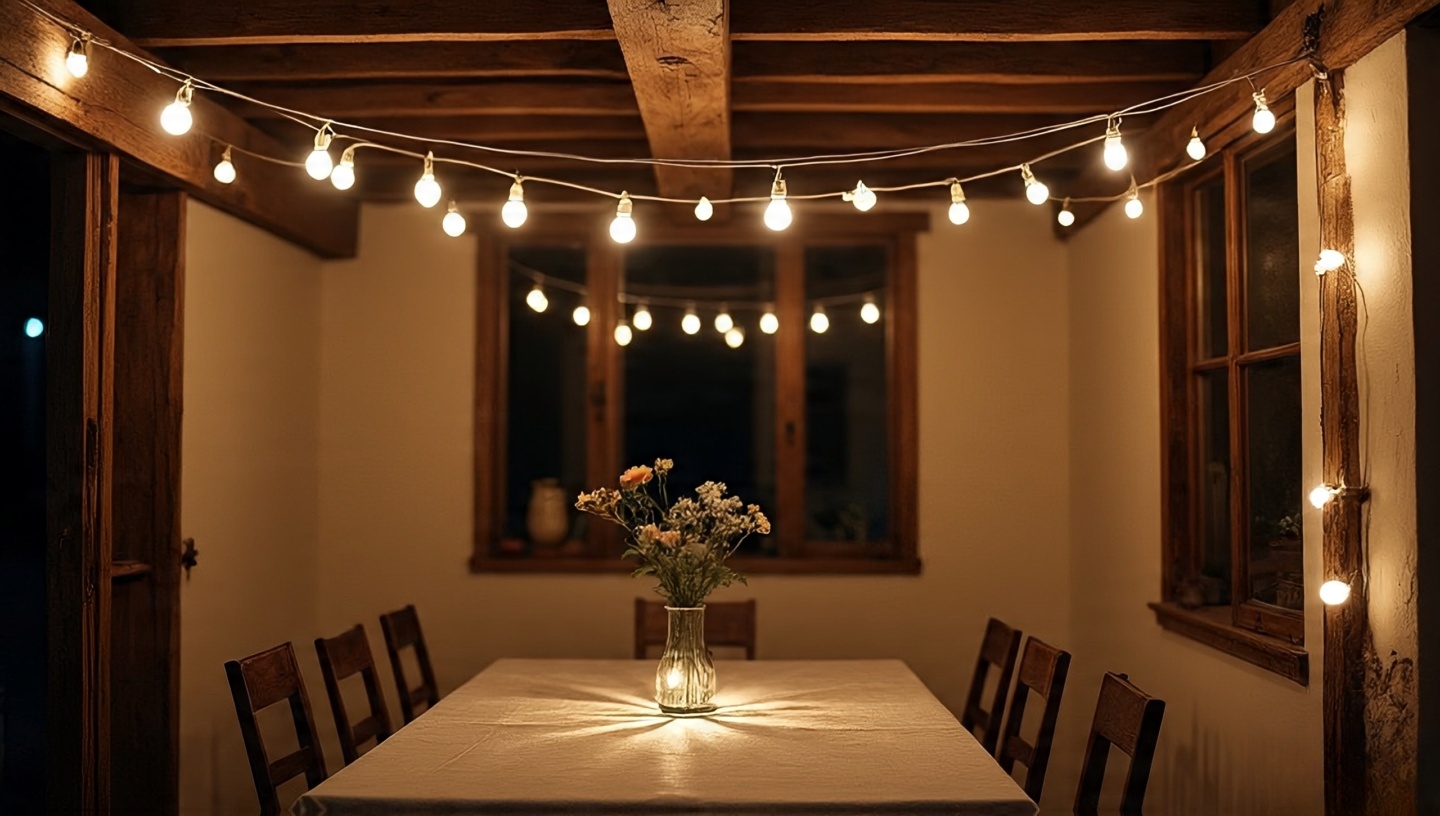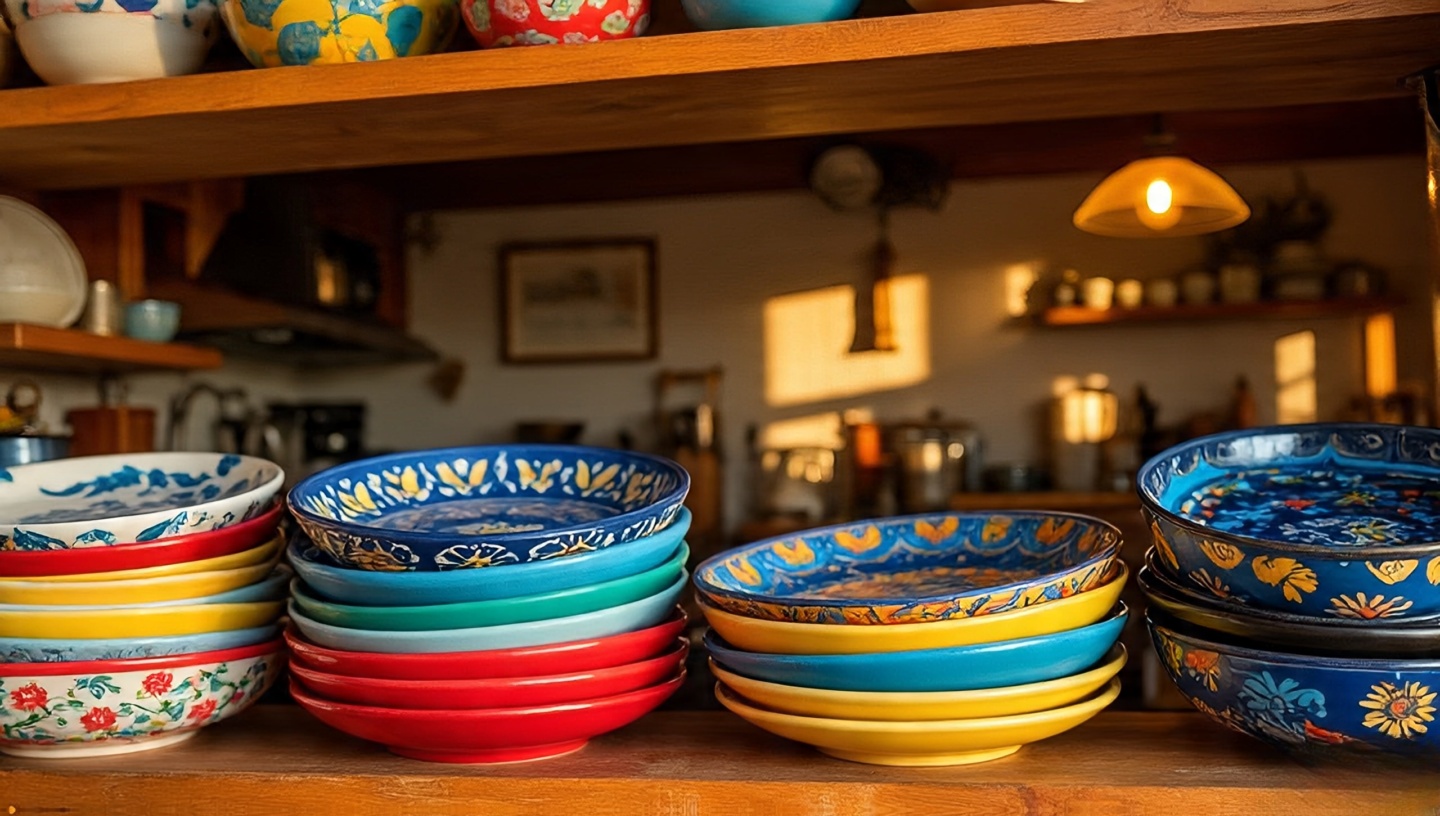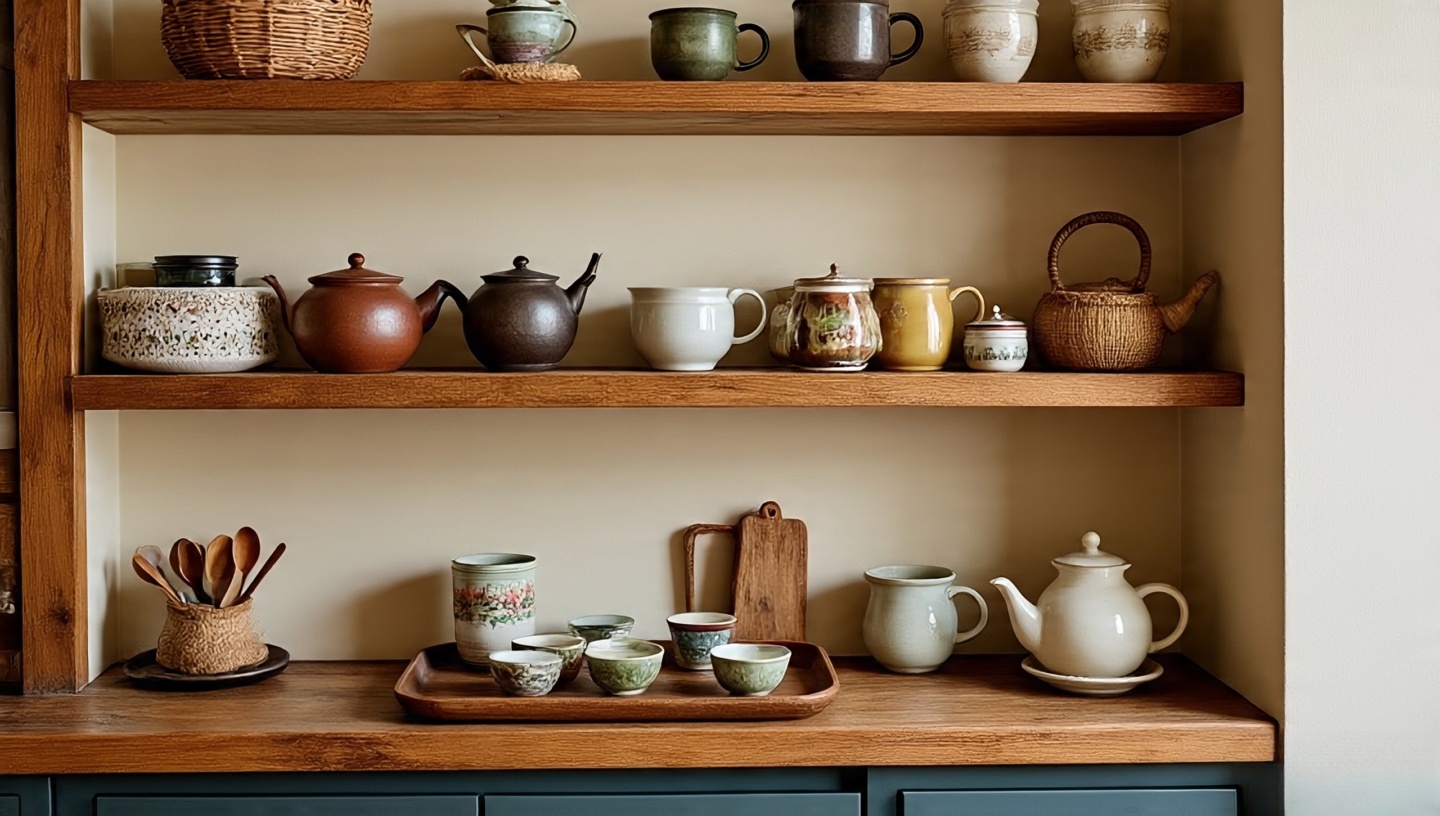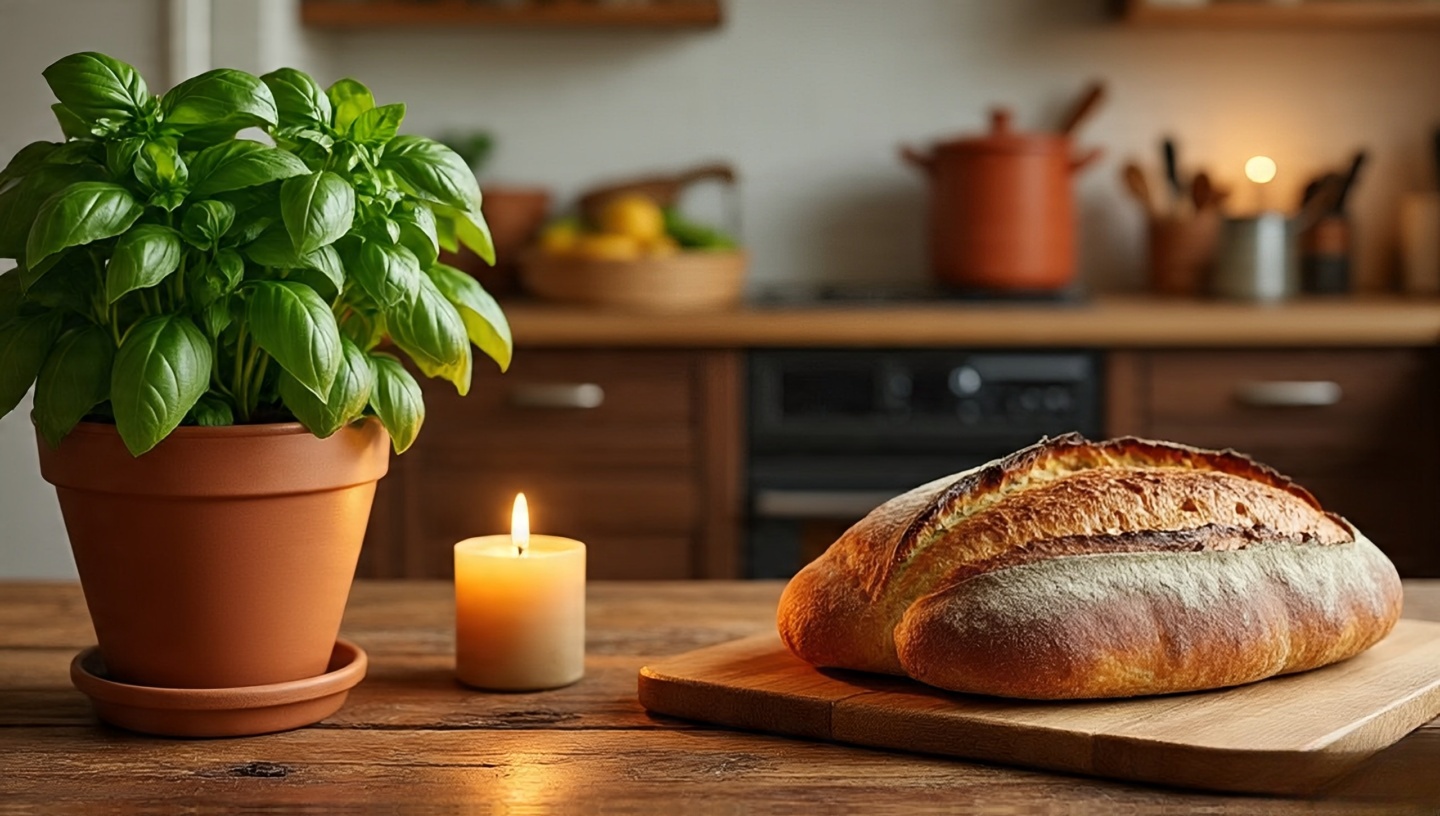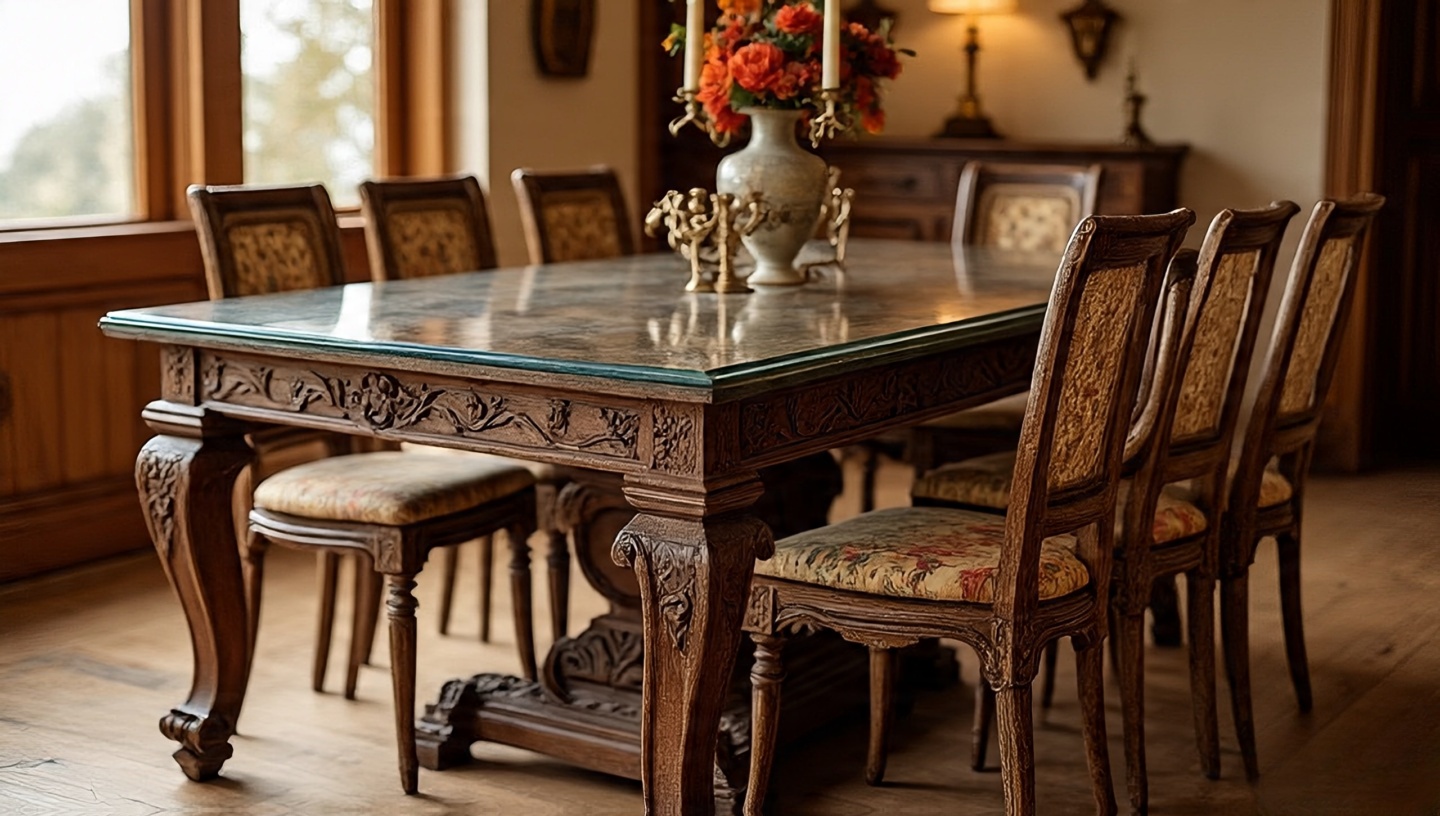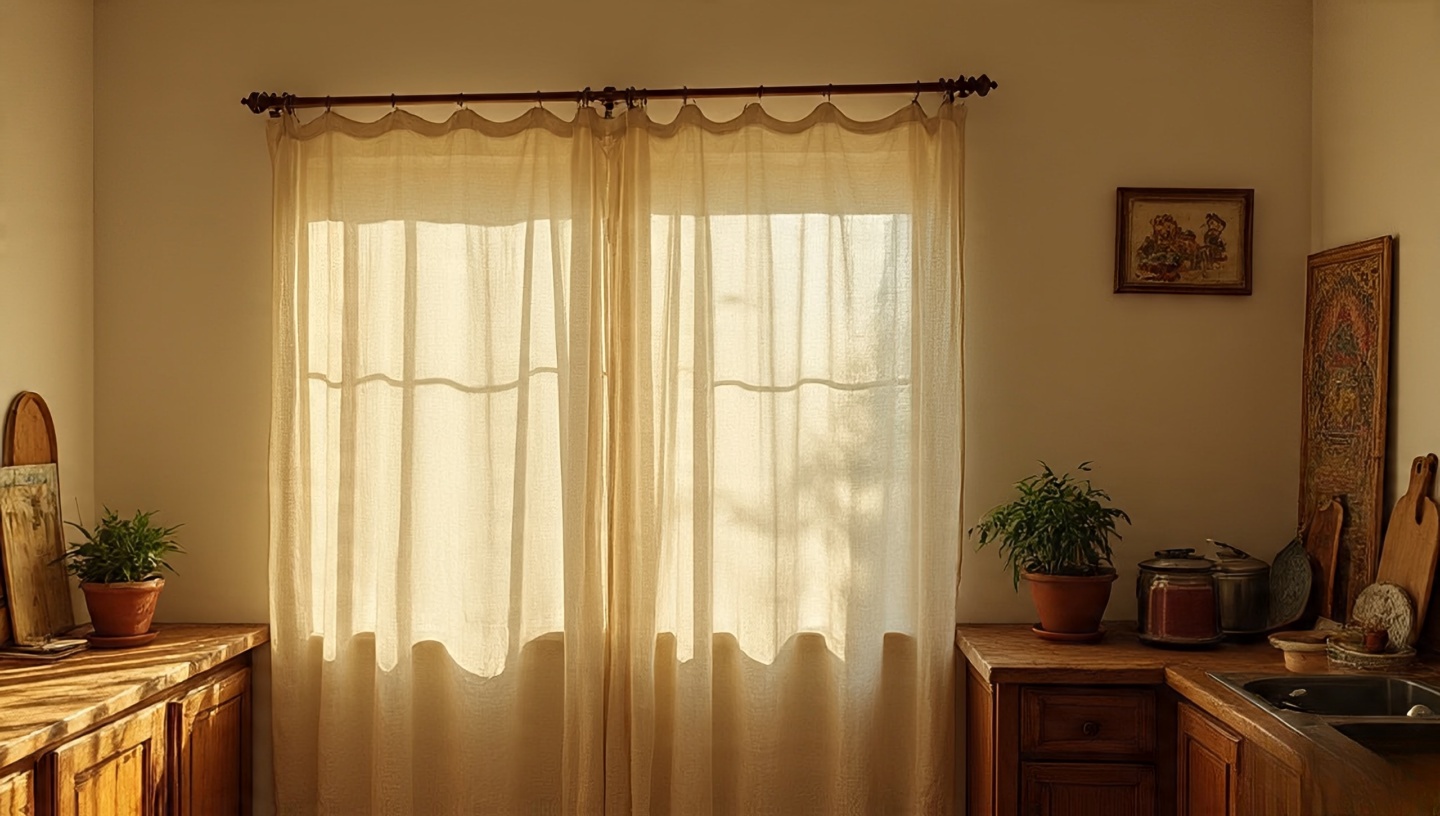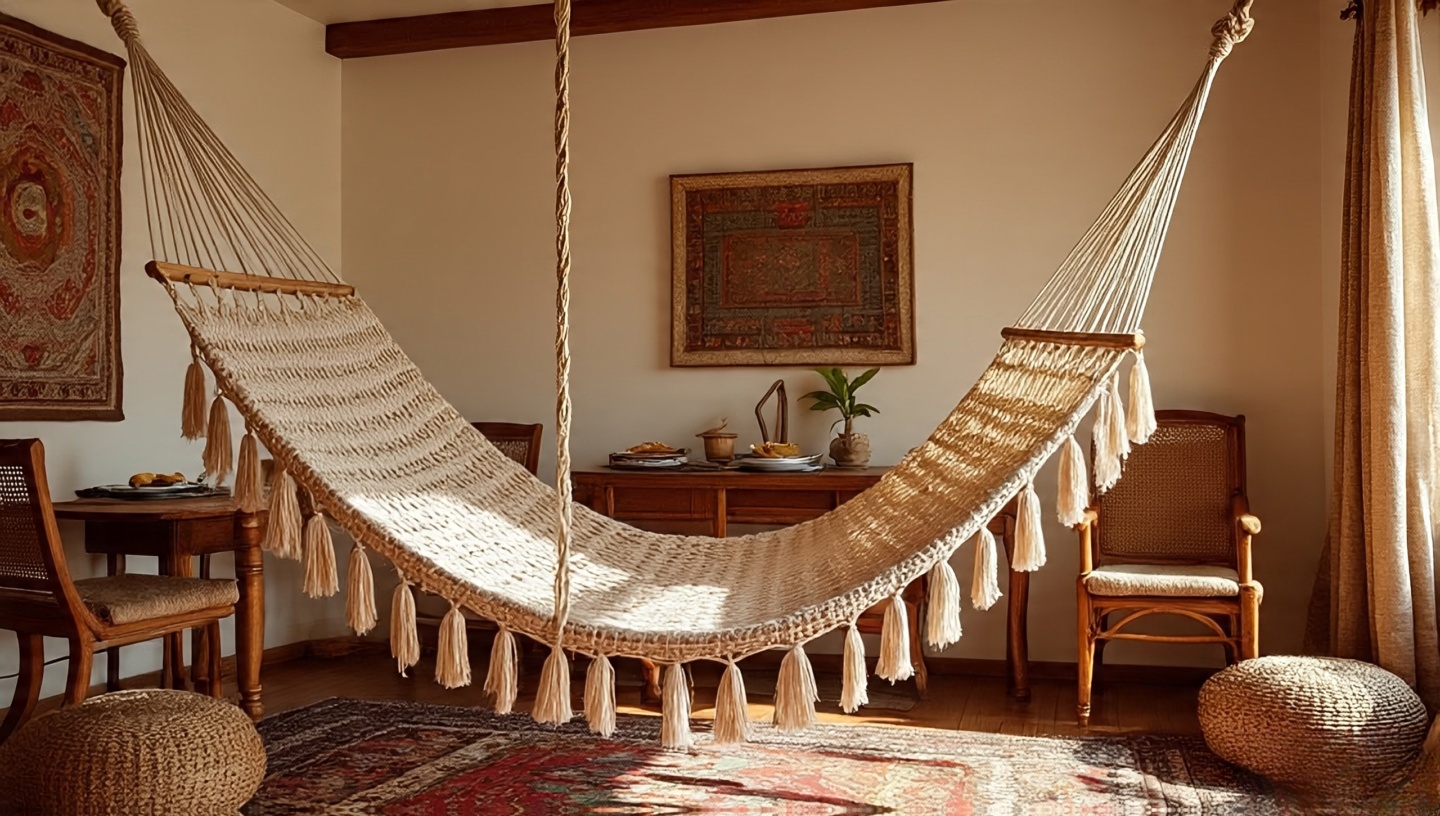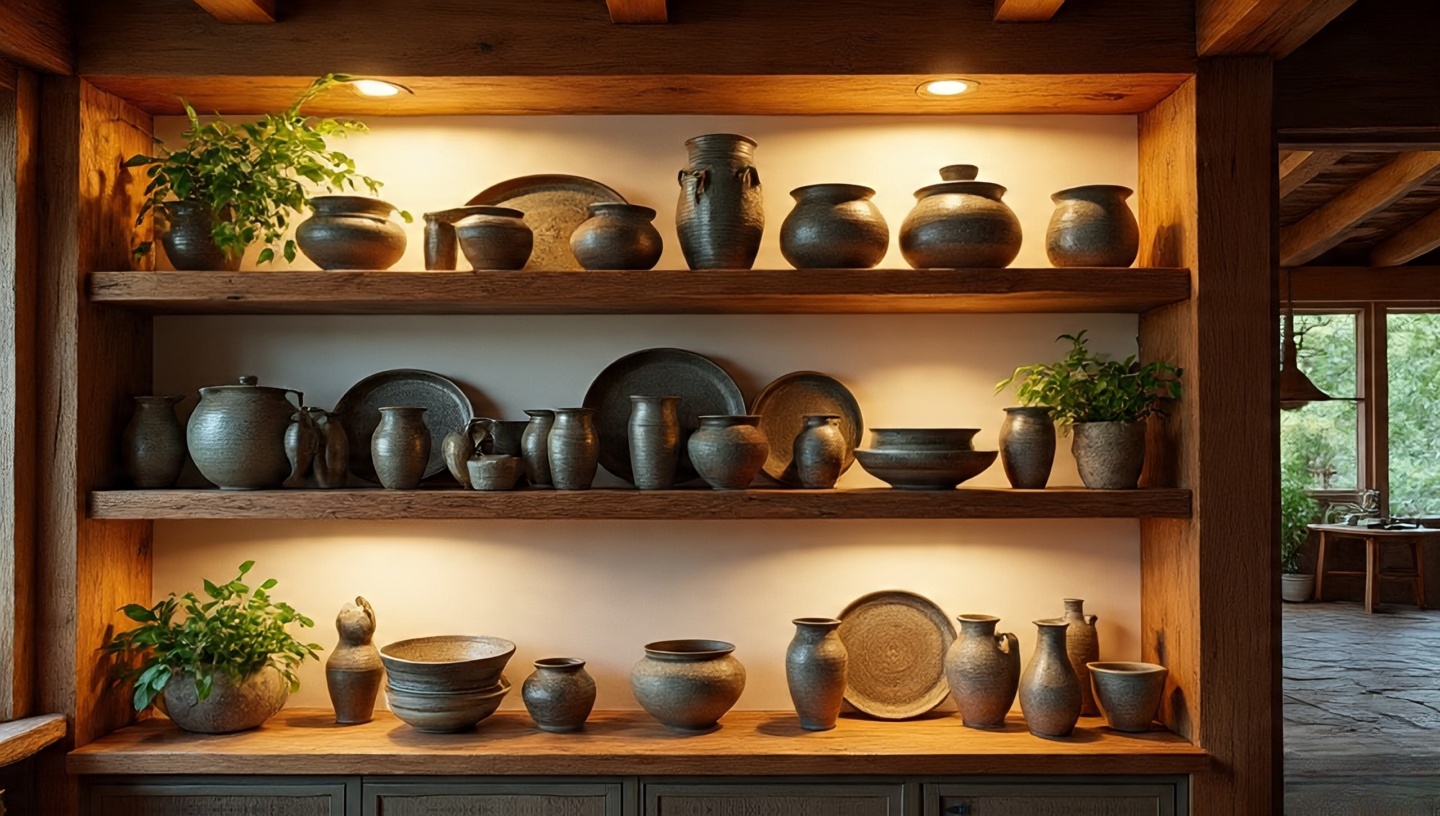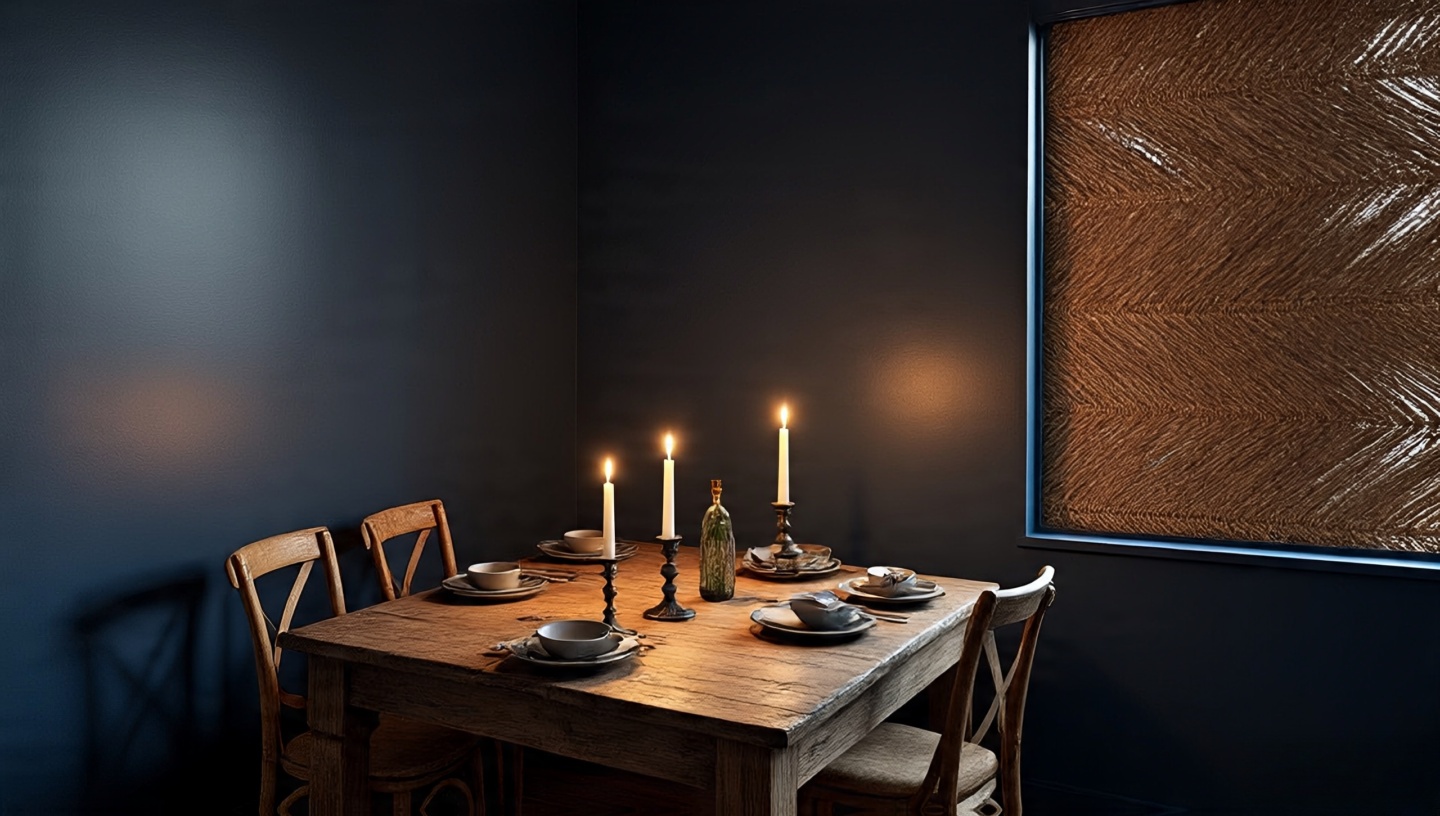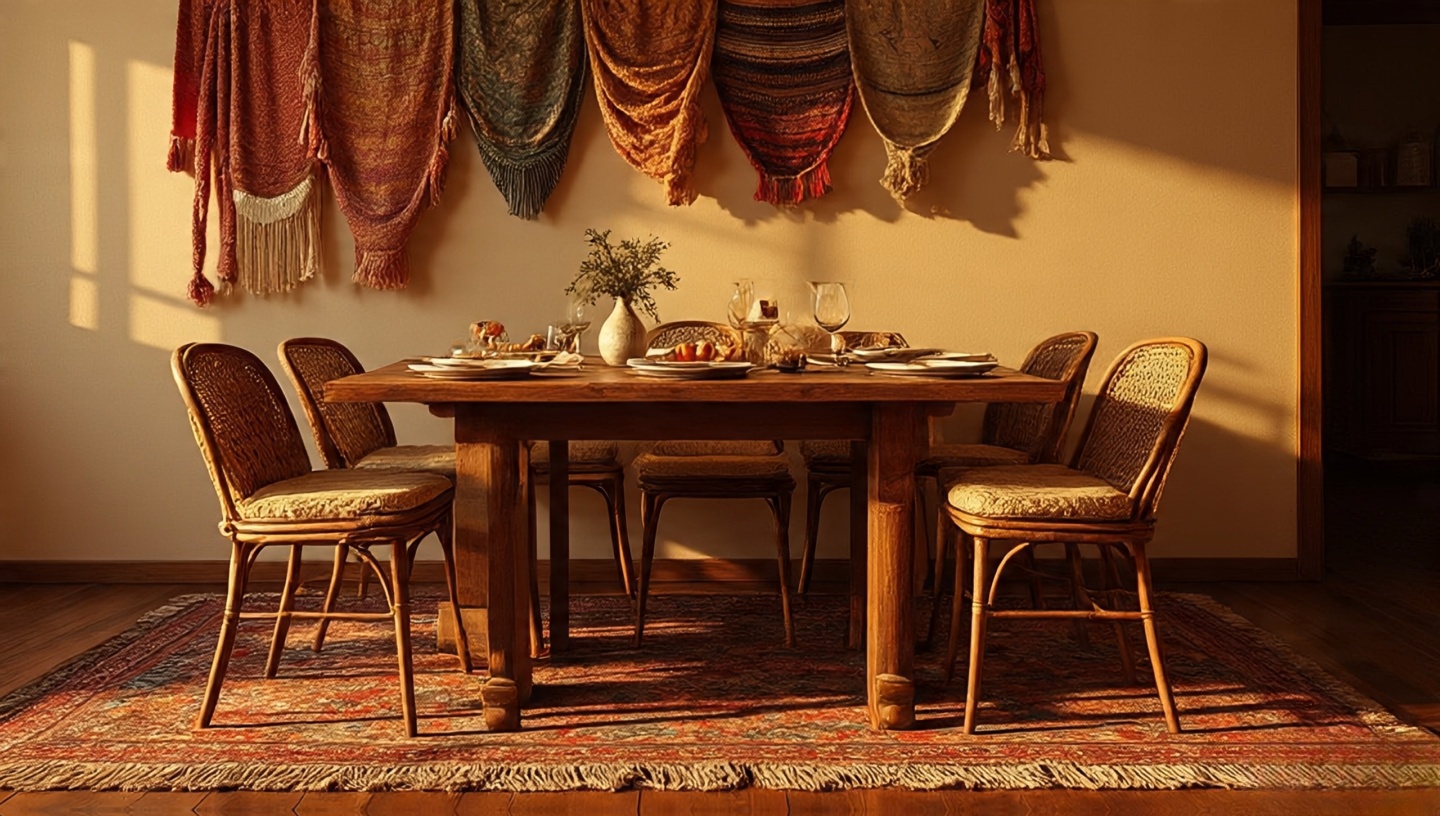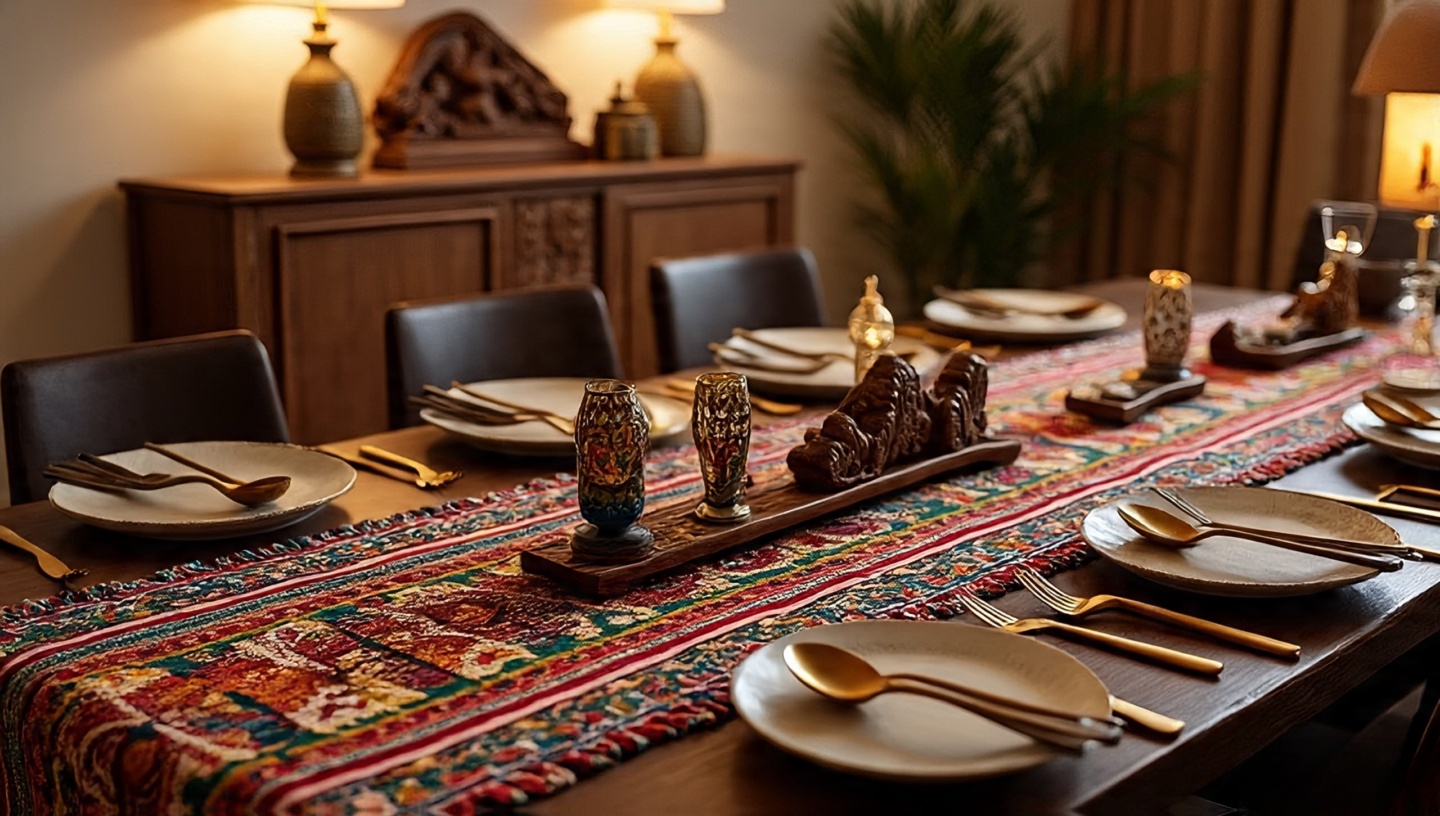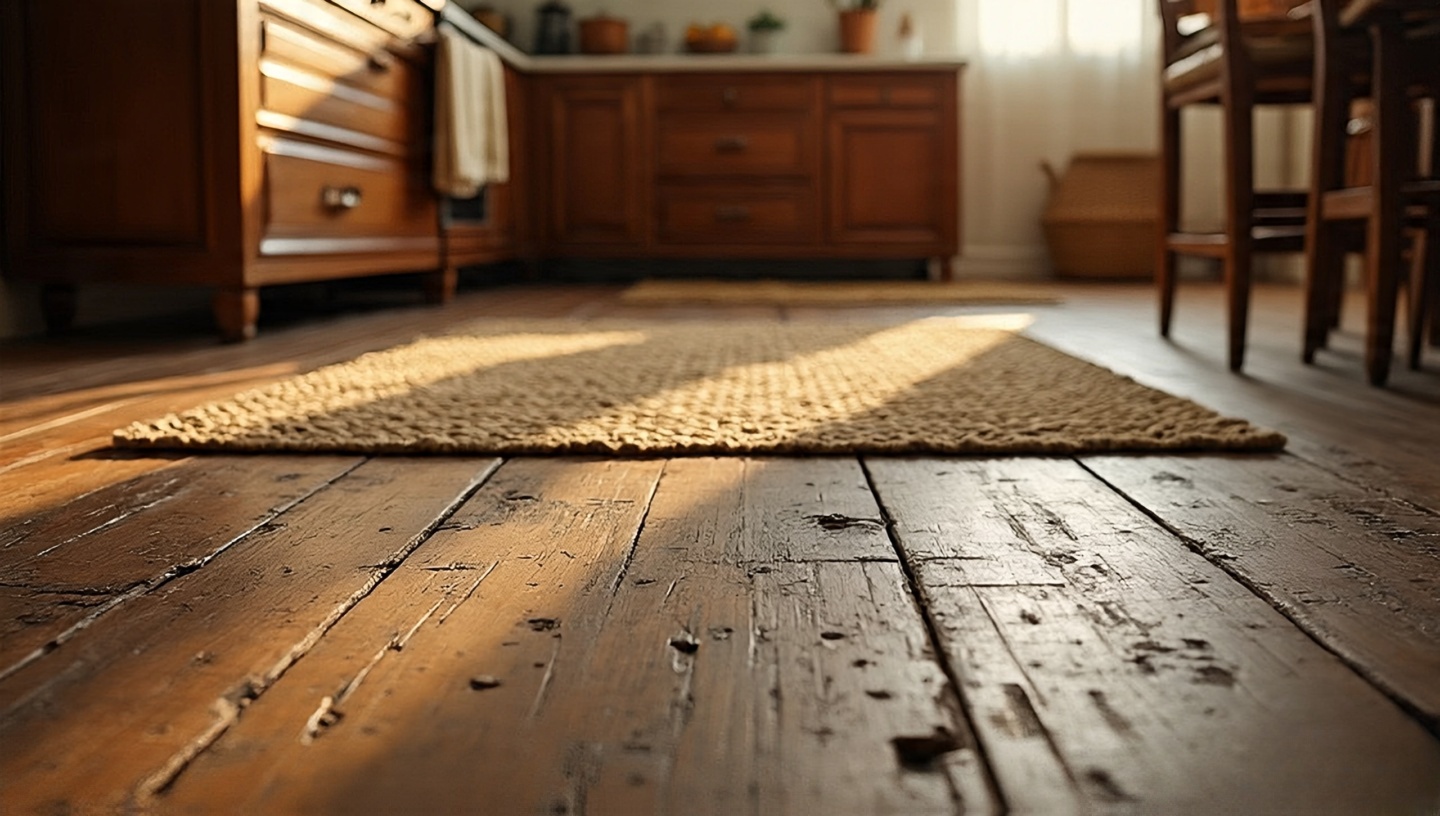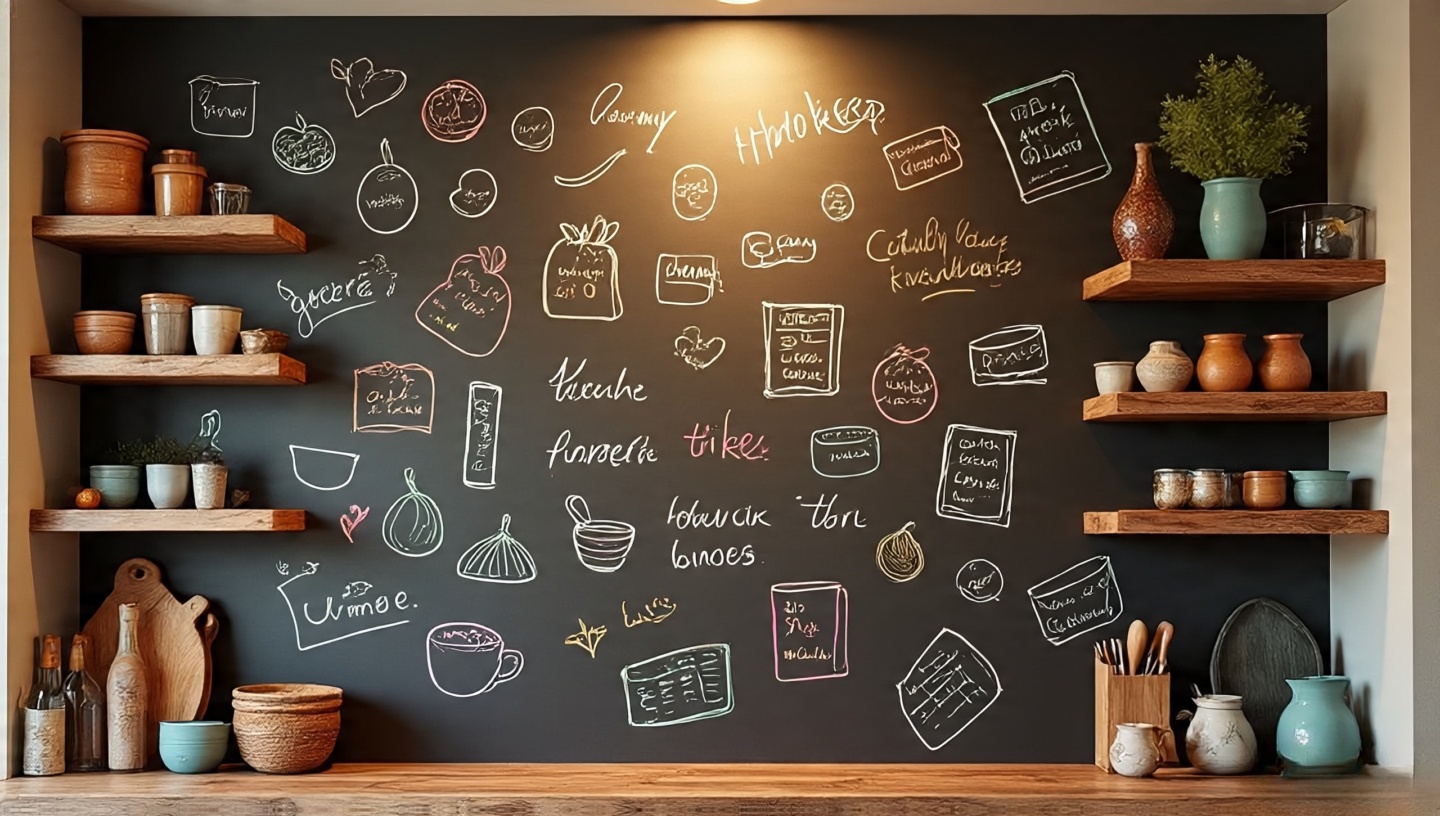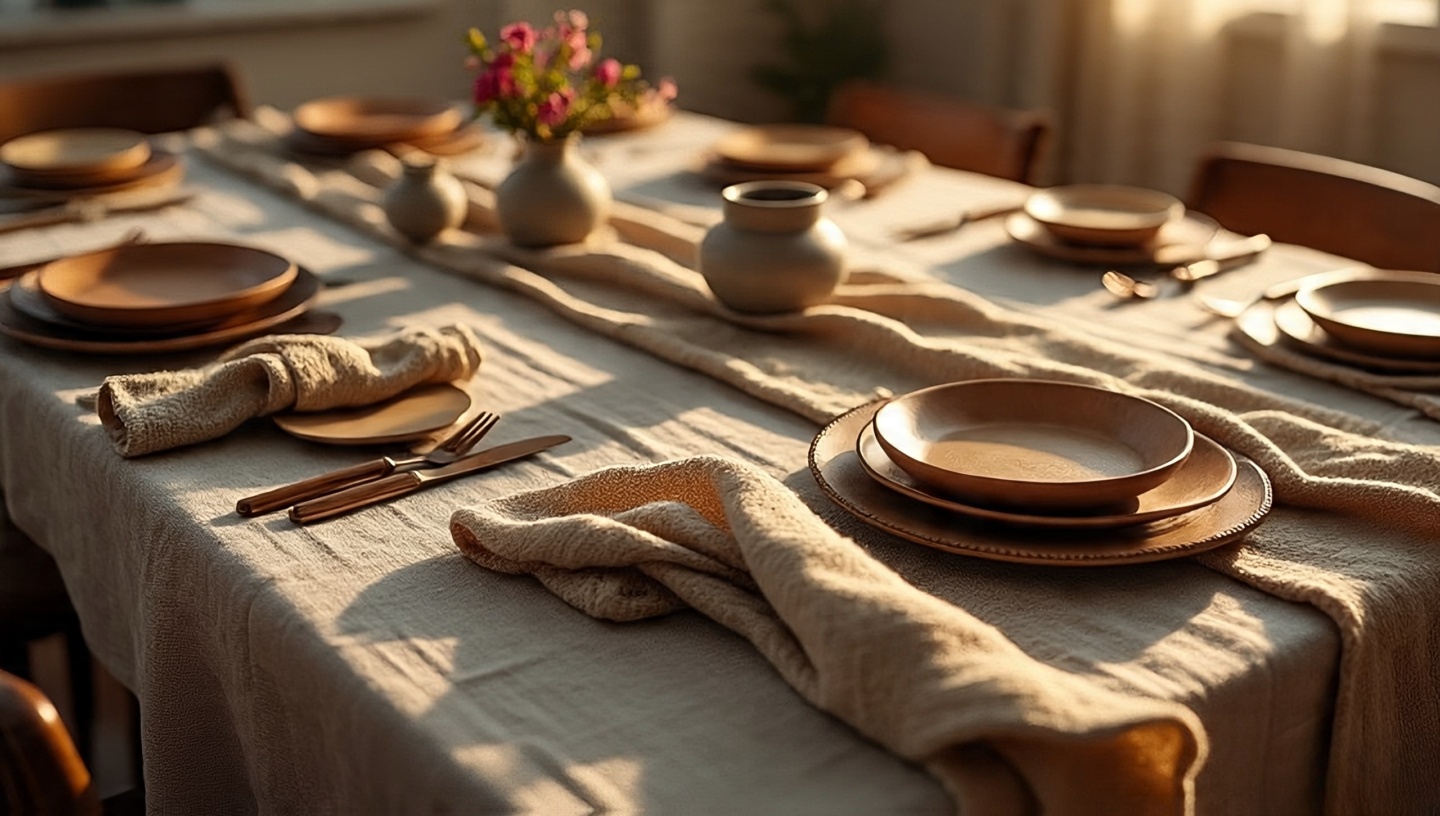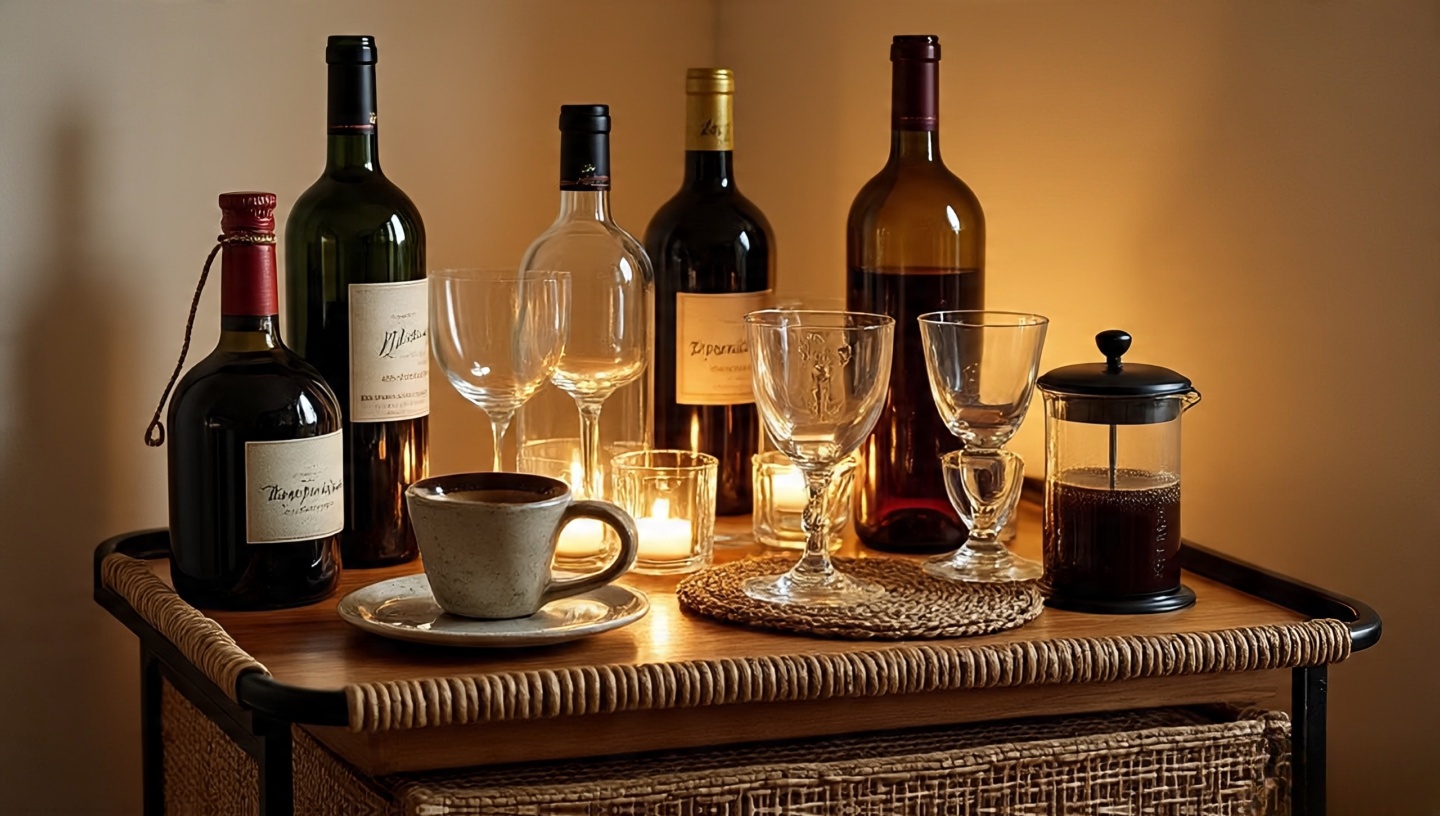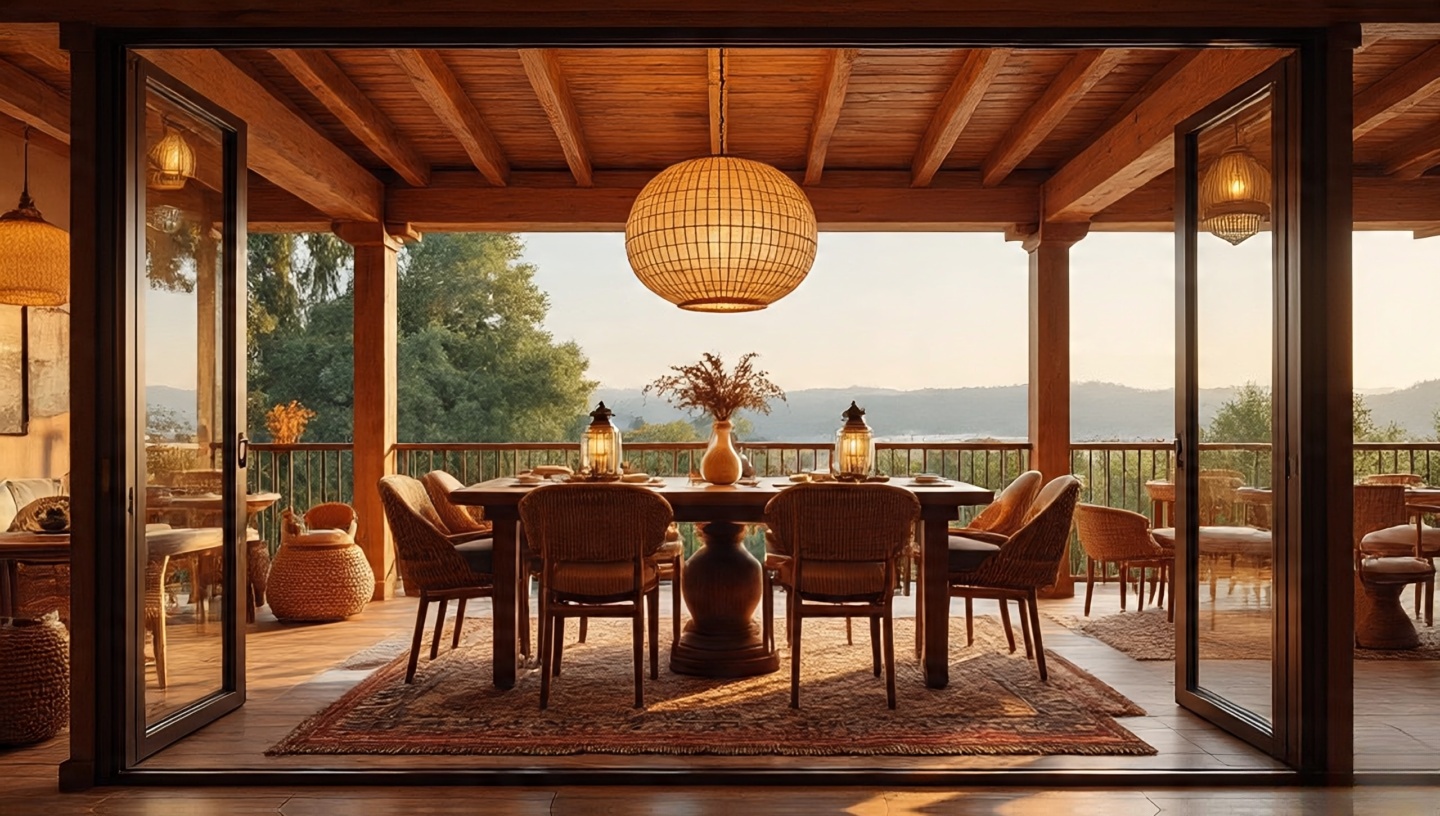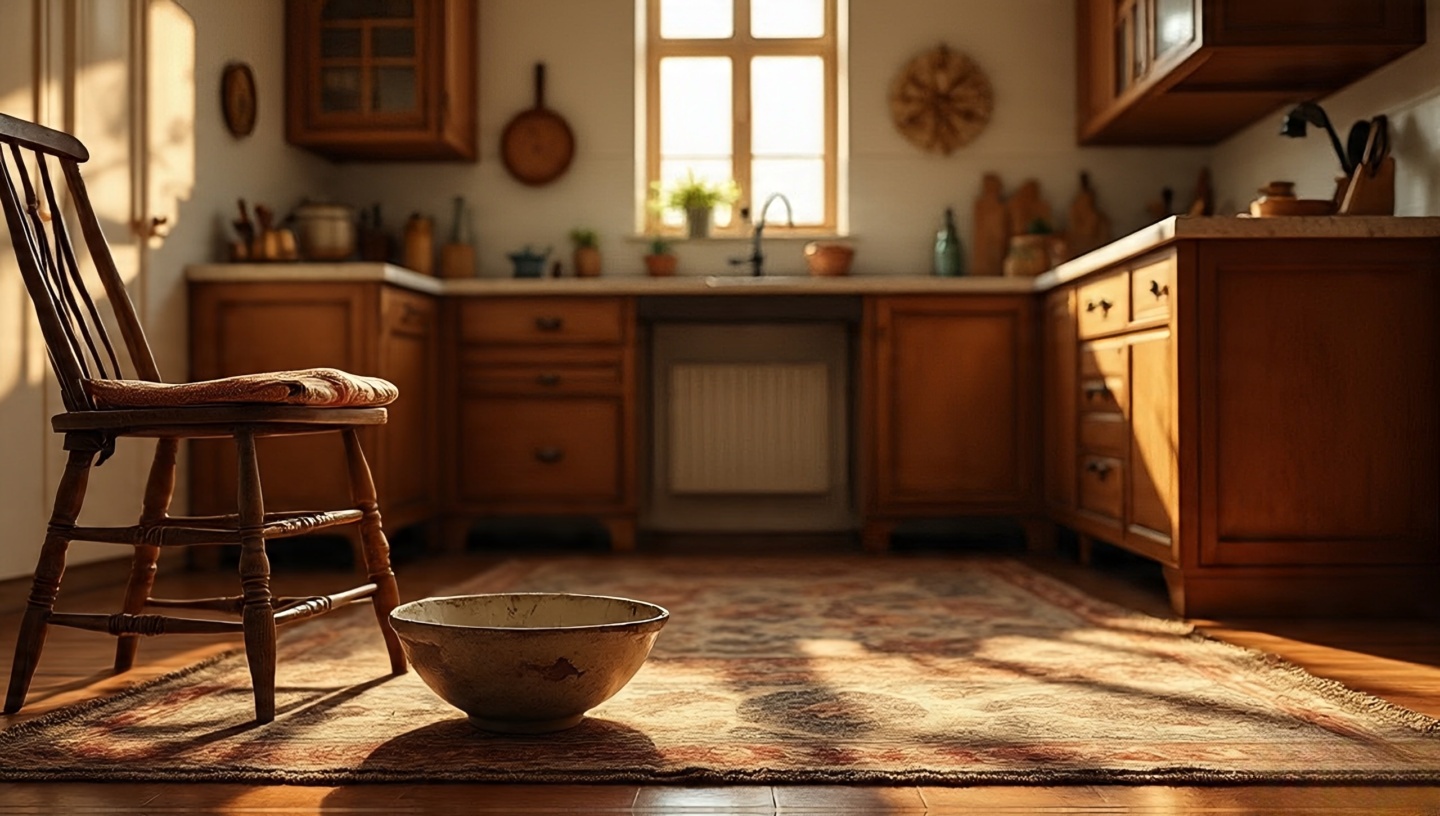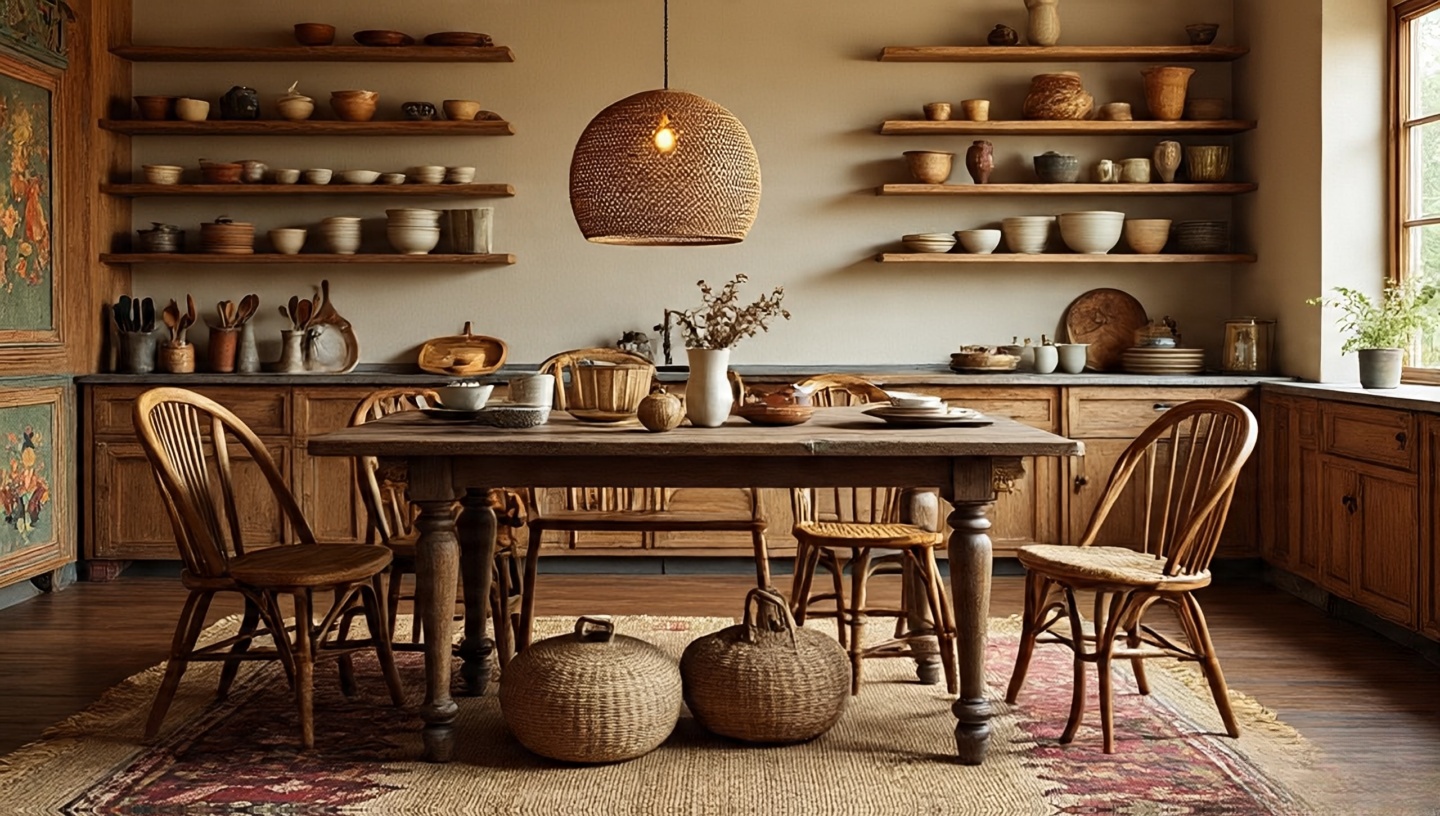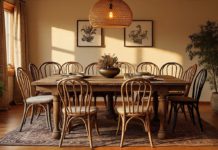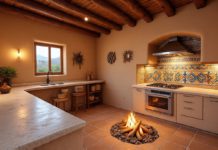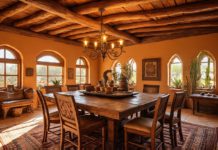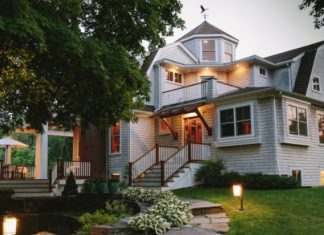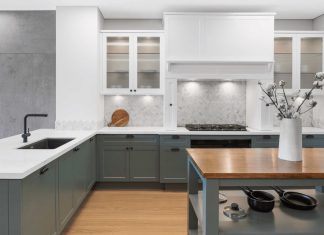Roohome.com – When people talk about Bohemian design, they often picture living rooms full of layered rugs or dreamy bedrooms with billowing fabrics. But the kitchen and dining area the true heart of the home deserves the same warmth and soul. I’ve learned that a boho kitchen isn’t just about eclectic décor; it’s about creating a space that feels lived-in, generous, and welcoming, whether you’re chopping onions or sipping coffee with friends. Here are 52 ideas to spark inspiration.
1. A wooden table that tells stories
After thirty years of working with homes, I can tell you: the table is never just a surface, it’s an anchor of memory. I remember running my hand across a reclaimed oak table in an old hacienda it was scarred by knives, softened by elbows, and still stood strong. That’s what you want: a table that lives with you, not against you.
Architect’s Tip: Choose reclaimed or imperfect wood. The irregularities are what make it inviting. If buying new, finish it with beeswax to bring out the grain and add a natural scent that deepens over time.
2. Mismatched chairs add life
Perfection is overrated. In one of my favorite projects, we mixed six different chair styles around a dining table cane, wicker, bentwood, even a painted metal chair. Instead of looking chaotic, it became playful, warm, and utterly personal. Guests never fought for the “good chair.” Every chair was a story.
3. Natural fibers everywhere
A room breathes differently when you bring in natural textures. Rattan pendants glow softer than glass, a sisal rug mutes footsteps, and linen napkins crumple in the most beautiful way. These are not just materials, they’re sensory experiences your feet on jute, your fingers brushing woven rattan, your eyes resting on soft cotton.
- Use woven baskets to store produce practical, but also sculptural.
- Hang a hemp or jute runner across the dining table to add grounding texture.
4. Open shelving with personality
Here’s the truth: people feel more comfortable when they see your shelves aren’t staged. I once designed a kitchen with floating oak shelves filled with hand-thrown pottery and mismatched glassware. Guests would reach for a mug like they were at home. That’s the boho spirit open, casual, and unfussy.
5. Color palettes that lean earthy
Terracotta, clay, olive, ochre… these tones feel timeless because they echo the earth itself. In the right light, sage green cabinets almost hum with calm. I’ve often told clients: “Choose a color you’ve seen in nature, not in a catalog.” The result is always richer and more enduring.
Pro Tip: Paint one wall in a deeper shade and let it anchor the lighter tones around it. The contrast creates quiet drama without overwhelming the room.
6. Layered textiles, yes even here
Some people balk when I suggest rugs in a kitchen. But imagine: warm wool underfoot on a cold morning, or a vintage runner guiding you down a galley kitchen. The key is choosing washable or durable weaves like kilim or flatweave. They add softness where hard tiles dominate.
7. Hanging herbs and dried flowers
One of my fondest kitchen memories is walking into a Tuscan farmhouse with bundles of lavender and rosemary swaying above the stove. The scent was intoxicating. Hanging herbs are both poetic and useful you’re decorating with ingredients. Plus, dried herbs last months and whisper of seasons gone by.
8. A kitchen island that feels like a gathering spot
So many islands today feel sterile, like airport counters. But an island should invite leaning elbows, spilled wine, and conversations that last an hour after the meal. Consider painting the base in a muted, earthy tone, or topping it with reclaimed wood. Pair it with stools that don’t match, and suddenly the island feels like a campfire everyone gathers there.
9. Moroccan tiles as a backsplash
I’ve worked with zellige tiles often, and every time they transform a space. Each hand-cut piece reflects light differently, so the wall looks alive throughout the day. In one project, the kitchen backsplash became the most photographed spot in the house not because it was perfect, but because it was human, imperfect, tactile.
10. Layered lighting
If you want a dining room to feel intimate, forget a single overhead bulb. I’ve always recommended layering: a pendant over the table, a soft lamp on the sideboard, and a candle or two at night. Light should shift as the day shifts. It’s like composing music high notes, low notes, and silence in between.
11. Plants, plants, and more plants
Every kitchen I’ve ever loved had something green in it. Not fake plants, but the real thing the kind that droops if you forget to water it and rewards you when you remember. A pothos trailing from a high shelf, basil on the sill, or even a lemon tree in a large clay pot. Plants clean the air, soften the corners, and remind you that life is thriving all around you.
Architect’s Reflection: Kitchens are functional, but plants keep them humane. They blur the line between indoors and outdoors, which is exactly what boho design celebrates.
12. Imperfect ceramics
I’ll take a hand-thrown bowl with a slightly crooked rim over a flawless factory plate any day. In one project, we curated open shelves with pottery made by local artisans. Guests would always pick up a piece, turning it over in their hands, as if the fingerprints embedded in the glaze told a secret story. That’s the kind of tactile honesty a boho kitchen deserves.
13. Vintage textiles on chairs
Here’s a small trick: drape a kilim rug across a dining bench or tie cushions made of kantha quilts to wooden chairs. Suddenly, a cold seat becomes a layered story of color and culture. Every meal feels warmer not because of the food, but because the textures embrace you before you even sit down.
14. A gallery wall near the dining nook
Most people don’t think of hanging art near the stove or dining table. But I insist on it. A small gallery wall a map, botanical prints, maybe even a thrifted portrait adds character to mealtime. One client told me she started lingering longer at the table, not because of the food, but because the wall across from her was simply delightful to look at.
15. Copper pots on display
Copper is honest. It darkens, it spots, it gleams again when polished. That patina is a record of every meal you’ve cooked. Hanging copper pots on a rail transforms them from tools into artwork. And when the morning sun strikes their surface? It feels like a spotlight on the history of your kitchen.
16. Boho meets minimal? Yes, it works
Some of my clients fear boho means “too much stuff.” But restraint can be bohemian, too. Picture a clean white kitchen where the only burst of texture is a woven pendant and a single terracotta pot. The contrast makes each element sing louder. Minimalism gives boho space to breathe.
17. The scent of spices on open shelves
Walk into a kitchen with jars of turmeric, cinnamon, star anise, and you’ll know instantly that food is not just fuel it’s culture. Spices are both functional and decorative. Their colors line up like a painter’s palette, and their scents remind you of faraway places. I’ve often said that a spice shelf is the cheapest artwork you’ll ever own.
- Use clear glass jars to show off the hues.
- Label them by hand it adds personality.
18. Handmade table runners
I love a table that changes its clothes. Swap a table runner depending on season or mood: bright woven patterns in summer, deeper tones in winter. Unlike placemats, runners create a sense of flow across the table, tying all the chairs together. Plus, they’re easier to wash and fold away when you’re not using them.
19. Cozy breakfast nooks
In one renovation, we built a simple bench under a south-facing window, added quilted cushions, and left it at that. The family ended up eating breakfast there every morning, sunlight spilling across their toast. It felt less like a designed corner and more like a café stumbled upon in a Moroccan alley. Sometimes the smallest changes yield the most joy.
20. The charm of clutter (the good kind)
Boho kitchens are not sterile they’re alive. A stack of cookbooks with dog-eared pages, a basket overflowing with apples, a jar of beans that makes a soft percussion when you move it. That’s the kind of clutter I encourage: intentional, not careless. It shows that a kitchen is used and loved, not staged for a magazine photo shoot.
Think of it this way: clutter is only a problem when it hides stories. When it tells them, it’s character.
21. Metallic accents for warmth
I’ve walked into many kitchens that felt cold until the smallest glimmer of metal warmed them up. A brass handle catching the light, a gold-rimmed glass, even a tarnished silver teapot left out on the counter. These details shimmer against earthy tones without screaming for attention. They’re the jewelry of a room subtle, but transformative.
22. A dining table under a statement pendant
Lighting has the power to define a dining space. I once designed a room where a woven pendant lamp, nearly oversized for the table, cast a honeycomb pattern across the walls every evening. Guests still remember it not the food, but the atmosphere. That’s what a statement piece does: it makes the ordinary unforgettable.
23. Boho benches beat extra chairs
There’s something wonderfully democratic about a bench. No armrests, no rules just sit where you like and squeeze in. Families with children love them because it invites togetherness. And in boho dining spaces, benches keep the energy casual, as if the meal might stretch into storytelling long after the plates are cleared.
24. The sound of clinking glass jars
Every architect notices sound in a space. Kitchens, especially, have their own rhythm. The gentle clink of glass jars, beans shifting inside, or lids popping open it’s domestic music. Fill your shelves with jars not just for storage, but to let sound and color become part of the room’s character.
25. Incorporating art directly onto cabinets
One of the boldest moves I’ve ever suggested was hand-painting cabinet doors with floral motifs. Risky? Yes. But it turned a plain white kitchen into a bohemian masterpiece. Cabinets don’t always have to be neutral; they can carry as much artistry as the walls. If painting feels too daring, try removable decals for a less permanent experiment.
26. Woven baskets for storage
Storage doesn’t need to be sterile. Woven baskets hide the onions, soften the hard lines of appliances, and add texture to overlooked corners. In many of my projects, baskets double as décor and function. They breathe better than plastic bins, and they age with charm, not cracks.
- Use small baskets for garlic and spices.
- Larger floor baskets can hold extra linens or even firewood if you have a nearby stove.
27. Candlelit dinners, even on weekdays
Why wait for a holiday? I tell homeowners this often: light a candle on a Tuesday. The flicker changes the scale of the room, shrinks it into intimacy. One client once told me her children started lingering longer at the table when candles were lit. That’s the power of atmosphere it reshapes behavior without a word.
28. Dining chairs with throws
A simple cotton throw or a sheepskin tossed over a chair makes a seat irresistible. Even empty, they whisper “come sit.” It’s a trick I’ve used in both mountain chalets and city apartments, because the psychology of comfort is universal: softness draws us in.
29. Painted ceilings
Most people forget the ceiling the “fifth wall.” I once painted a dining ceiling in deep turquoise, and suddenly the whole room felt like a sky turned upside down. Bold? Yes. But paint is reversible, and sometimes the ceiling is the only place left to play. A touch of color above keeps the eye moving, which makes small dining rooms feel more dynamic.
30. Layers of rugs under the table
Yes, rugs under dining tables can work, despite the skeptics. The secret? Flatweaves that can handle crumbs and chairs sliding over them. Layering two rugs a neutral jute with a patterned kilim on top creates depth and softness underfoot. And when someone kicks off their shoes mid-meal, they’ll thank you.
Think of rugs not just as decoration, but as stage curtains for the theater of meals.
31. Old mirrors bouncing light
Light is the most precious material in design. A distressed mirror leaning against a kitchen wall doesn’t just add character it multiplies the sunlight, sending it dancing into dark corners. I’ve seen small, narrow kitchens feel twice as large just because of one well-placed mirror.
Pro Tip: Don’t polish it too much. Let the patina stay; it tells a story and softens the reflection.
32. A touch of whimsy
In one boho kitchen I designed, the owner strung tiny paper lanterns above the cabinets. Silly? Maybe. But every time the lights flicked on, the room felt like a street festival. Whimsy doesn’t have to be logical it has to make you smile. That’s reason enough.
33. Low tables and floor seating
Borrowing from Moroccan and Japanese traditions, a low table surrounded by cushions invites people to sit differently, linger differently, even eat differently. Meals at ground level feel less formal, more communal. Children, especially, love it because it feels like play disguised as dinner.
34. String lights draped casually
I’ll confess: I’ve used string lights in more kitchens than I can count. They cost little, but they bring warmth instantly. Draped across a beam, woven along a window, or even piled in a glass jar they’re the most democratic lighting source, equal parts humble and magical.
35. Painted mismatched plates
Food always tastes better when served on something joyful. Painted plates, especially when no two match, bring energy to the table before the first bite. In one dining space, we displayed stacks of brightly painted dishes on open shelves it looked like a living art installation.
36. A corner dedicated to tea
Not every kitchen needs a massive coffee station. Sometimes, a small tea nook a few handmade teapots, tins of chai spices, mugs collected from travels becomes a sanctuary. I had a client who called hers “the five-minute vacation corner.” A ritual, built right into the walls of home.
37. Layers of scent
Design isn’t only visual. Walk into a boho kitchen and it should smell alive. Fresh basil in a terracotta pot, a loaf of bread just out of the oven, maybe a sandalwood candle burning quietly. These scents weave together into an invisible design element. I’ve always said: people remember the way a room made them feel, and scent leads the memory.
38. Reclaimed doors as dining tables
One of my proudest repurposes was turning an antique carved door into a dining table. We laid a glass top over it to make cleaning easy, but the details beneath remained visible. Guests would trace the carvings with their eyes as they ate. It turned dinner into storytelling before the first course was served.
39. The play of sunlight
I urge clients not to over-dress windows. Let sheer linen curtains flutter. Let the sun paint shadows of plants across the walls. In a boho kitchen, light becomes a design collaborator, not an afterthought. You’ll never tire of watching how morning and evening transform the same space completely.
40. Hand-woven hammocks or swings nearby
It sounds extravagant, but why not? In one open-plan home, we hung a cotton hammock near the dining space. It became the most fought-over spot kids curled up after meals, adults drifted into conversation. A swing or hammock softens the atmosphere instantly. It says: this is a home meant for living, not just looking pretty.
41. Handmade pottery displayed proudly
I always encourage clients to invest in pieces made by human hands. A set of handmade bowls, each slightly different in shade or shape, carries more soul than a perfectly matched set from the store. Display them on open shelves, let guests see them. They become part of the décor even when empty.
42. Dark, moody corners
Not every space has to be drenched in sunlight. A dining corner painted in deep indigo or charcoal creates a cocoon where candlelight flickers like stars. I’ve found that darker hues in small areas can actually make the experience of eating feel more intimate, like the world outside has been muted just for you.
43. The hum of conversation as design
People often forget: acoustics shape the way we feel in a room. A boho kitchen, with its rugs, textiles, and layered materials, naturally softens sound. That means laughter carries warmly instead of echoing harshly. I’ve seen families talk longer, stay longer, simply because the space invited conversation. That, to me, is design success.
44. Incorporating global finds
Every trip can find its way into your kitchen. A Peruvian textile as a table runner, Turkish spoons, Balinese wood carvings all become stories woven into daily life. I once designed a dining space where every object had a passport. Meals there always felt like journeys, even if the menu was just soup and bread.
45. Imperfect floors are fine
A scuffed wooden plank, a tile with a small chip these are not flaws, they’re layers of history. I’ve learned over decades that perfection is sterile. Let your floor show its age. Cover parts with a woven rug if you like, but don’t erase the marks of life. They are proof that the room is used, loved, and alive.
46. Chalkboards for spontaneity
I adore chalkboard walls in kitchens. Grocery lists, doodles from kids, a handwritten quote they keep the space playful. In one project, a family used theirs to write the menu each evening. Guests loved it, even when it was just “spaghetti again.” It’s an easy, inexpensive way to make the kitchen interactive.
47. Mixing high and low
I’ve always believed boho is about freedom, not price tags. A designer chair can sit next to a flea-market find and both will shine. What matters is not uniformity, but contrast. In fact, that juxtaposition polished next to humble is where the magic happens.
48. Layering textures on the table
Food tastes better when the table feels alive. A linen cloth, a wool runner, clay plates the layering of textures creates an experience for the fingertips as much as the palate. I’ve seen guests linger, absentmindedly stroking the fabric beneath their glass. That kind of tactile richness is rarely noticed, but always felt.
49. Hidden corners for wine or coffee
Every home deserves a ritual corner. It doesn’t need to be large: a bar cart tucked beside the dining table, or a small shelf devoted to coffee. These corners become daily sanctuaries, places where a simple act pouring a glass, grinding beans feels ceremonial.
50. A dining room that flows outdoors
One of the most rewarding designs I’ve ever completed blurred the line between kitchen and garden. Wide doors opened to a patio layered with rugs and lanterns. Meals spilled outside naturally, with no need for formality. When weather permits, this transition makes dining endless, like nature itself has joined the table.
51. The joy of imperfection
Boho design thrives on imperfection. A chipped mug, a crooked chair leg, a fabric that’s a little faded they remind us we’re human. I’ve spent too many years watching people chase flawlessness in their homes. But here’s the secret: the rooms that feel best are the ones that dare to be imperfect.
52. Make it your own
After thirty years of architecture and design, I’ve learned this: a space only succeeds if it reflects the people who live in it. Your boho kitchen and dining area should carry your fingerprints your travels, your quirks, your memories. Collect, layer, experiment. It’s not about matching a style guide. It’s about walking into the room and feeling at ease, like you’ve arrived where you truly belong.
And yes, don’t underestimate candles. Even on a Tuesday night, they make ordinary soup taste like an occasion.
Want more Boho inspiration?
If this guide sparked ideas, you might also enjoy exploring these other spaces: Bohemian Bedroom Ideas, Bohemian Interior Design Guide, and Bohemian Living Room Ideas. Together, they form a whole-home approach to soulful design.
And that’s it. Maybe start small hang a woven pendant or drape a vintage textile on your dining bench. See how it feels. You’ll notice how the room changes, how meals stretch longer, how conversations deepen. That’s the real heart of a boho kitchen: not perfection, but connection.

